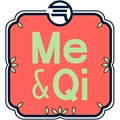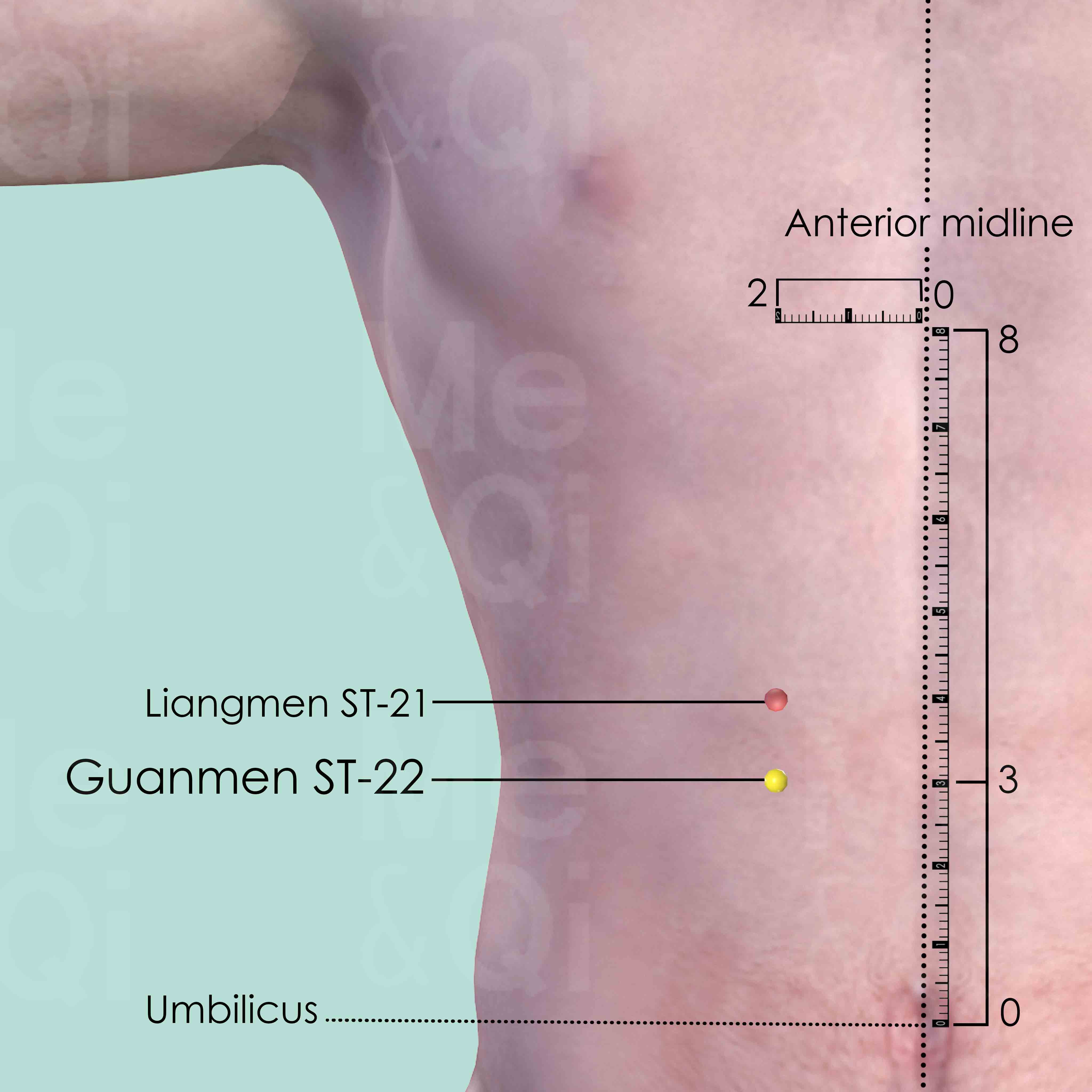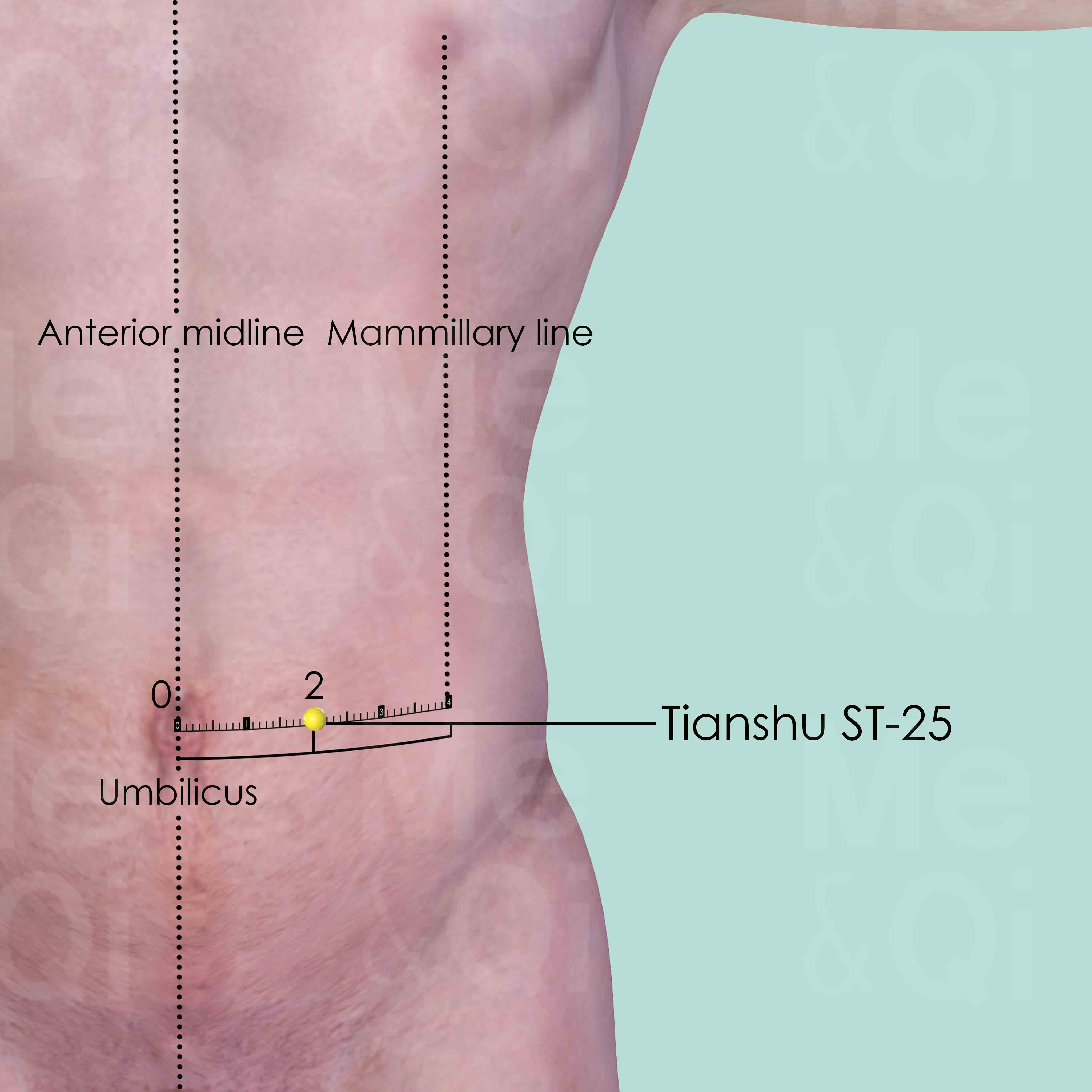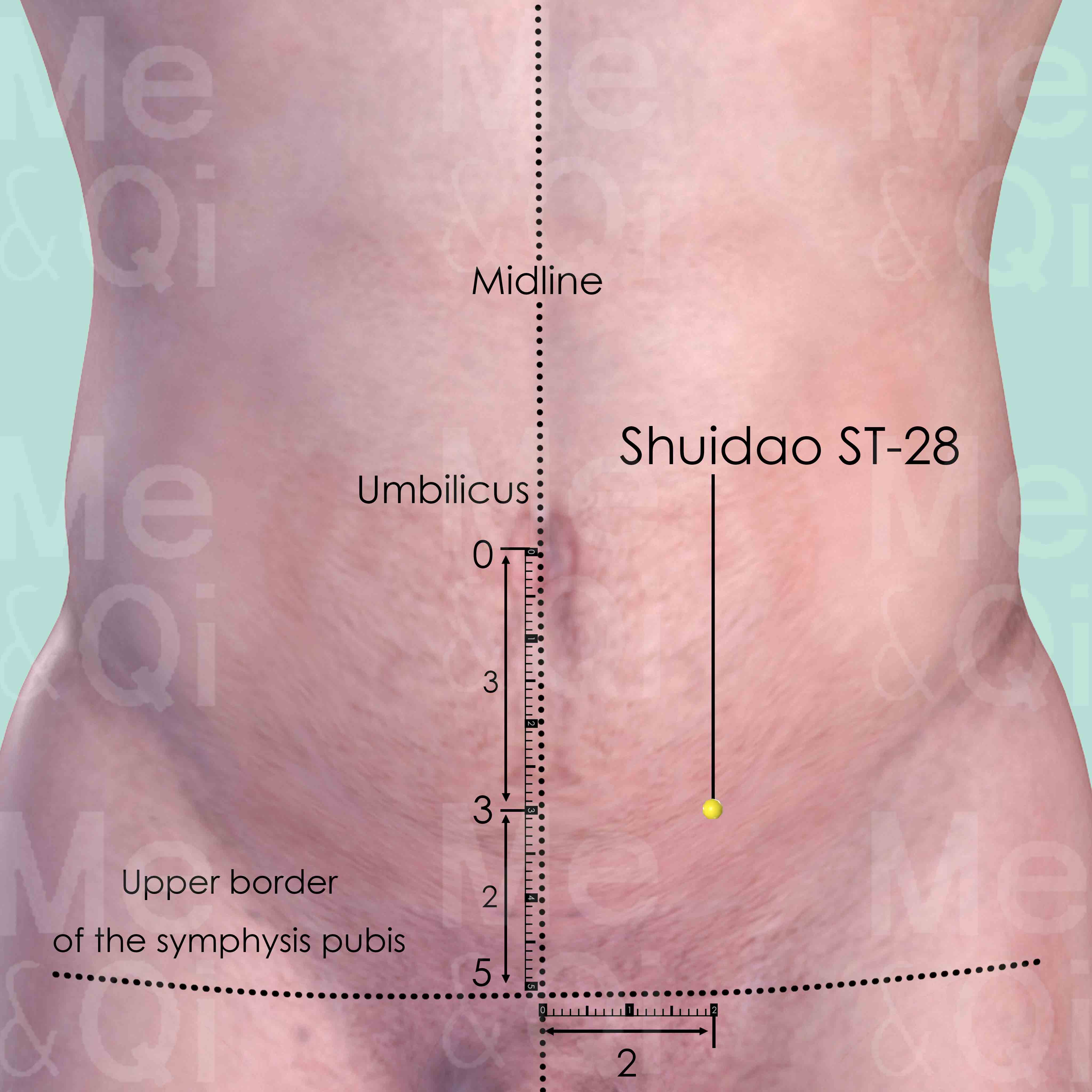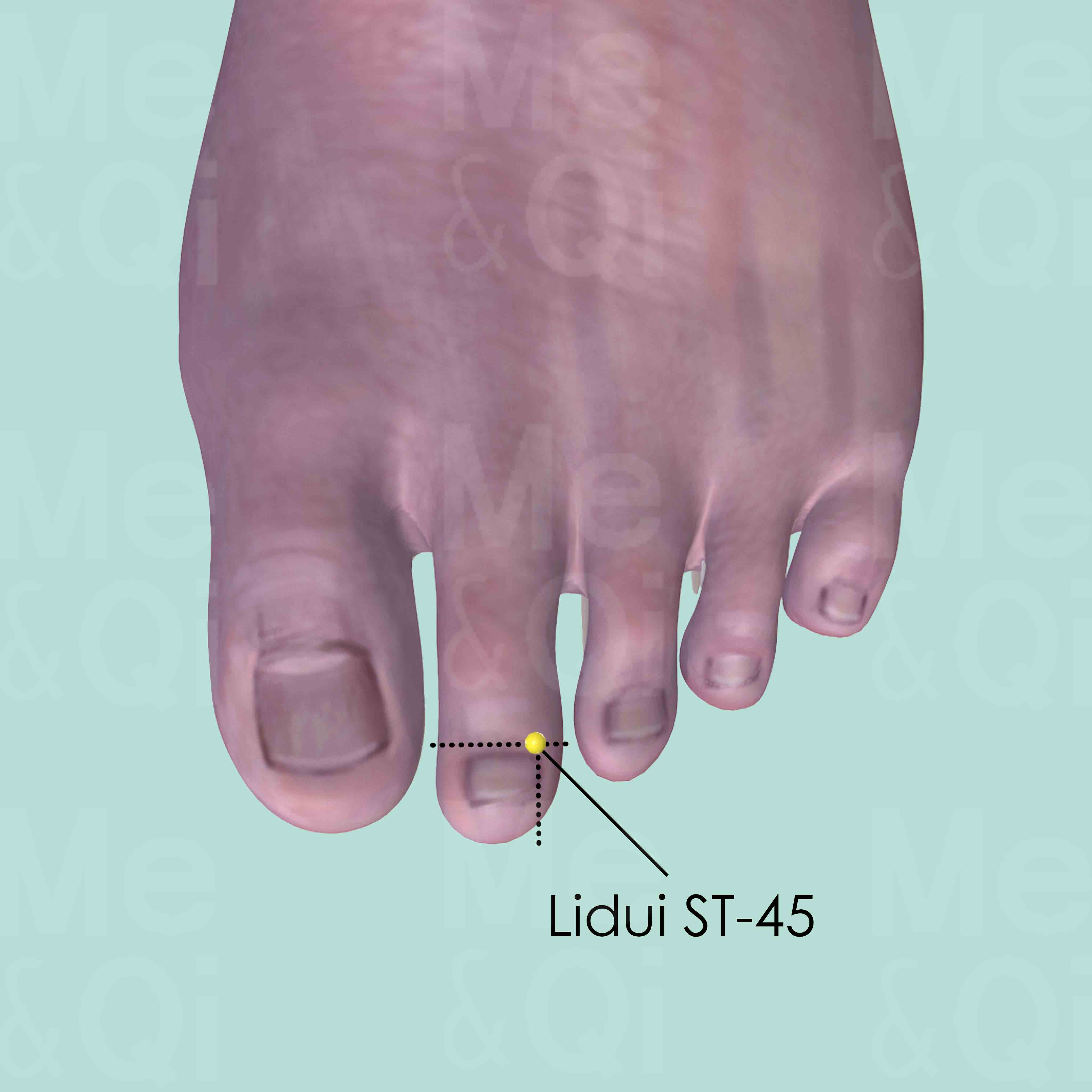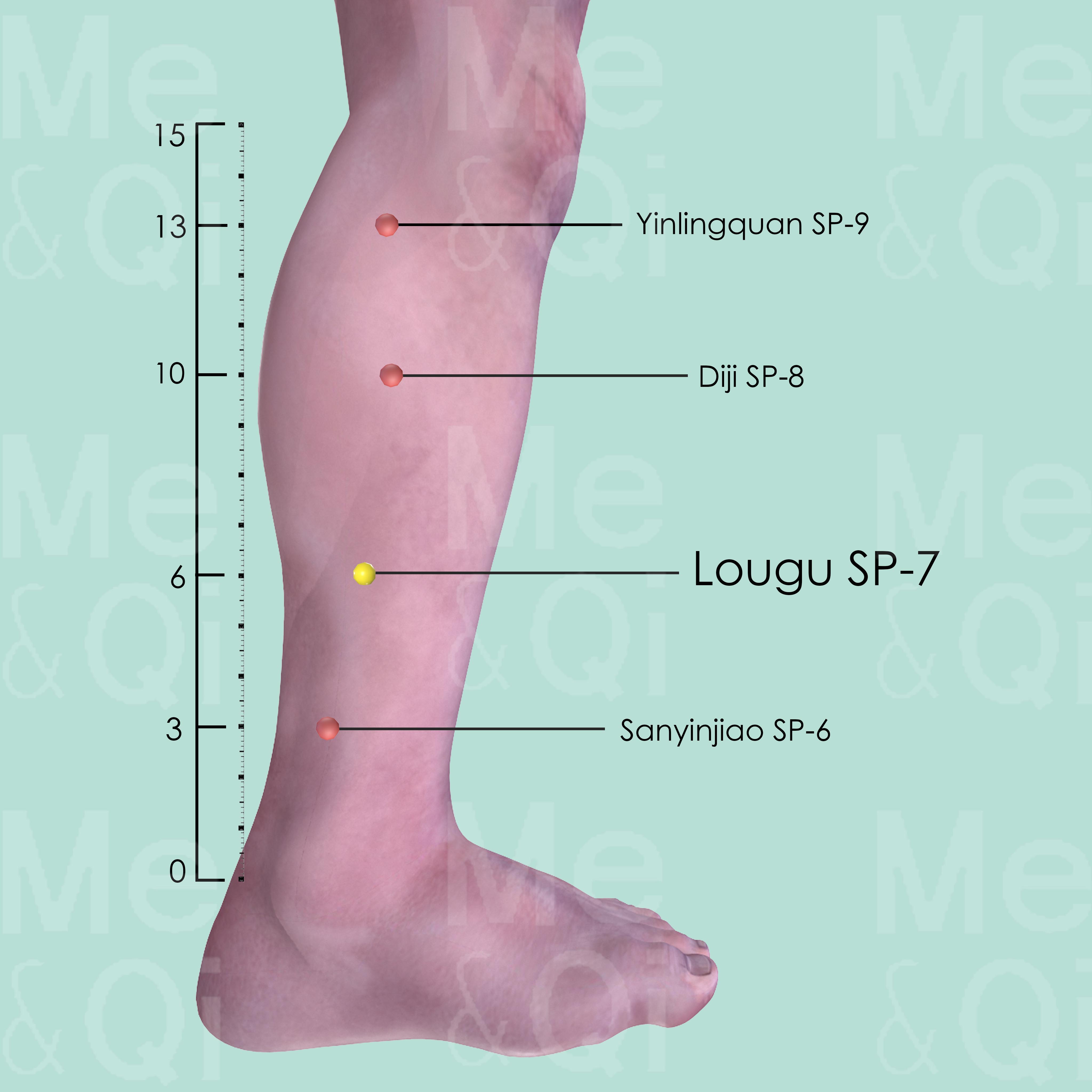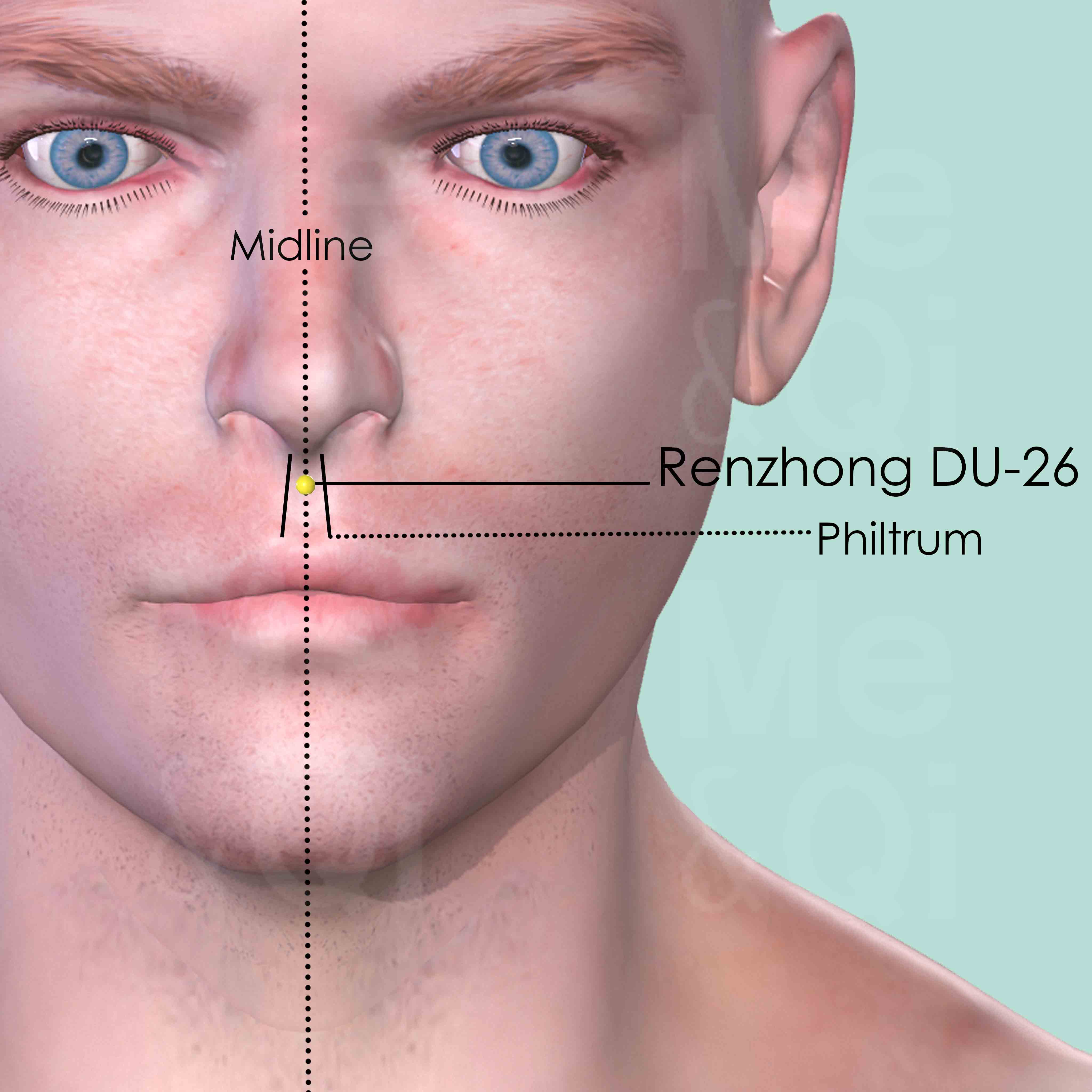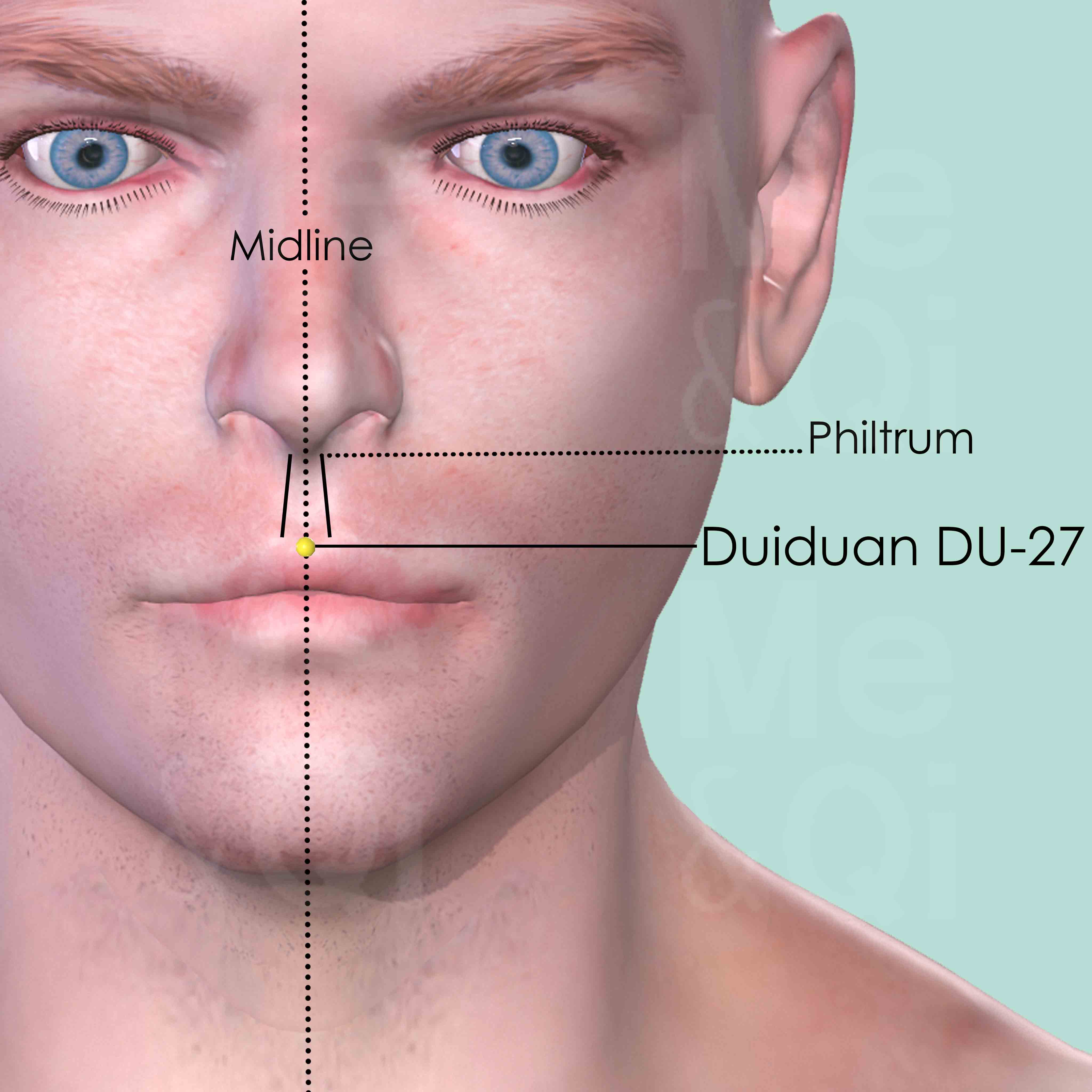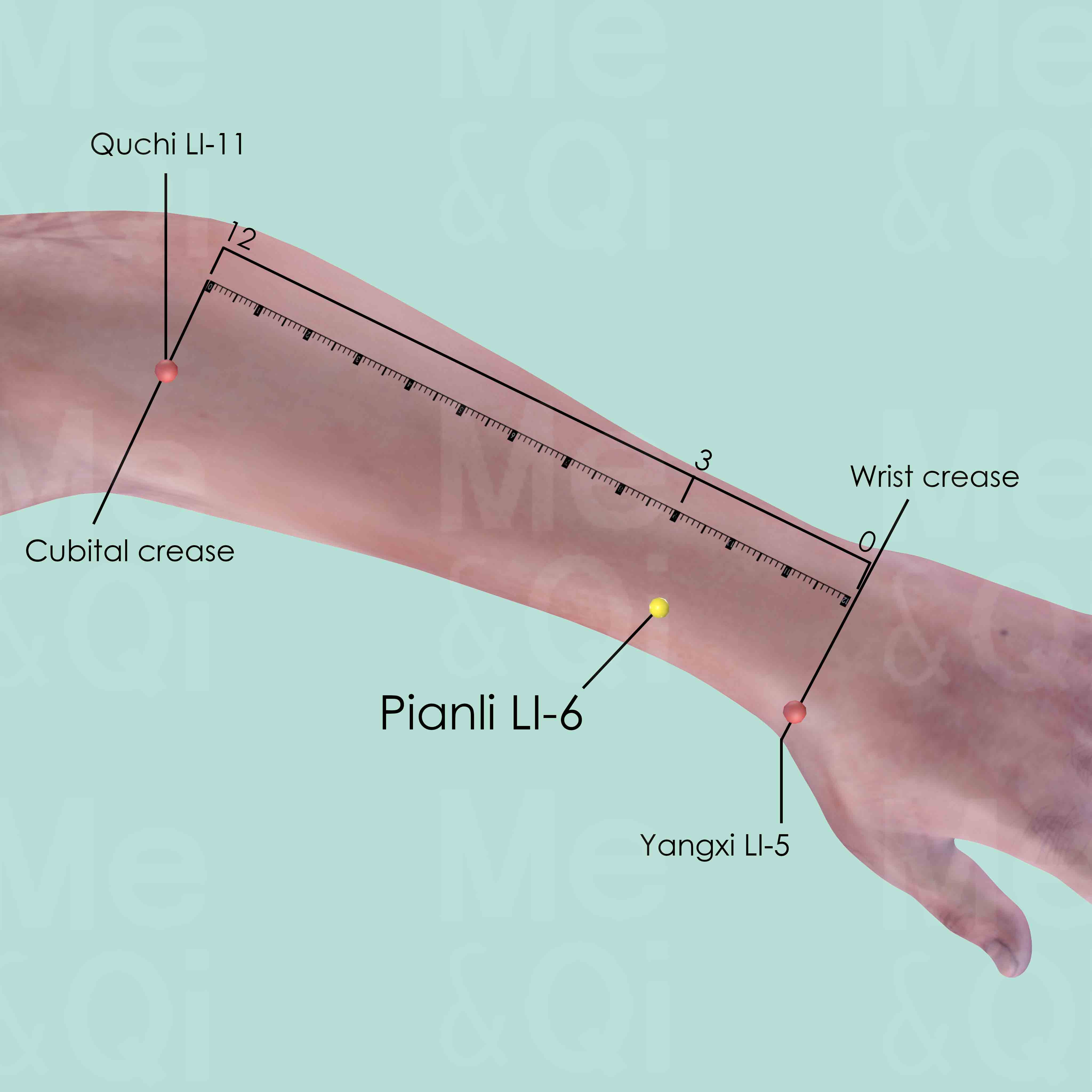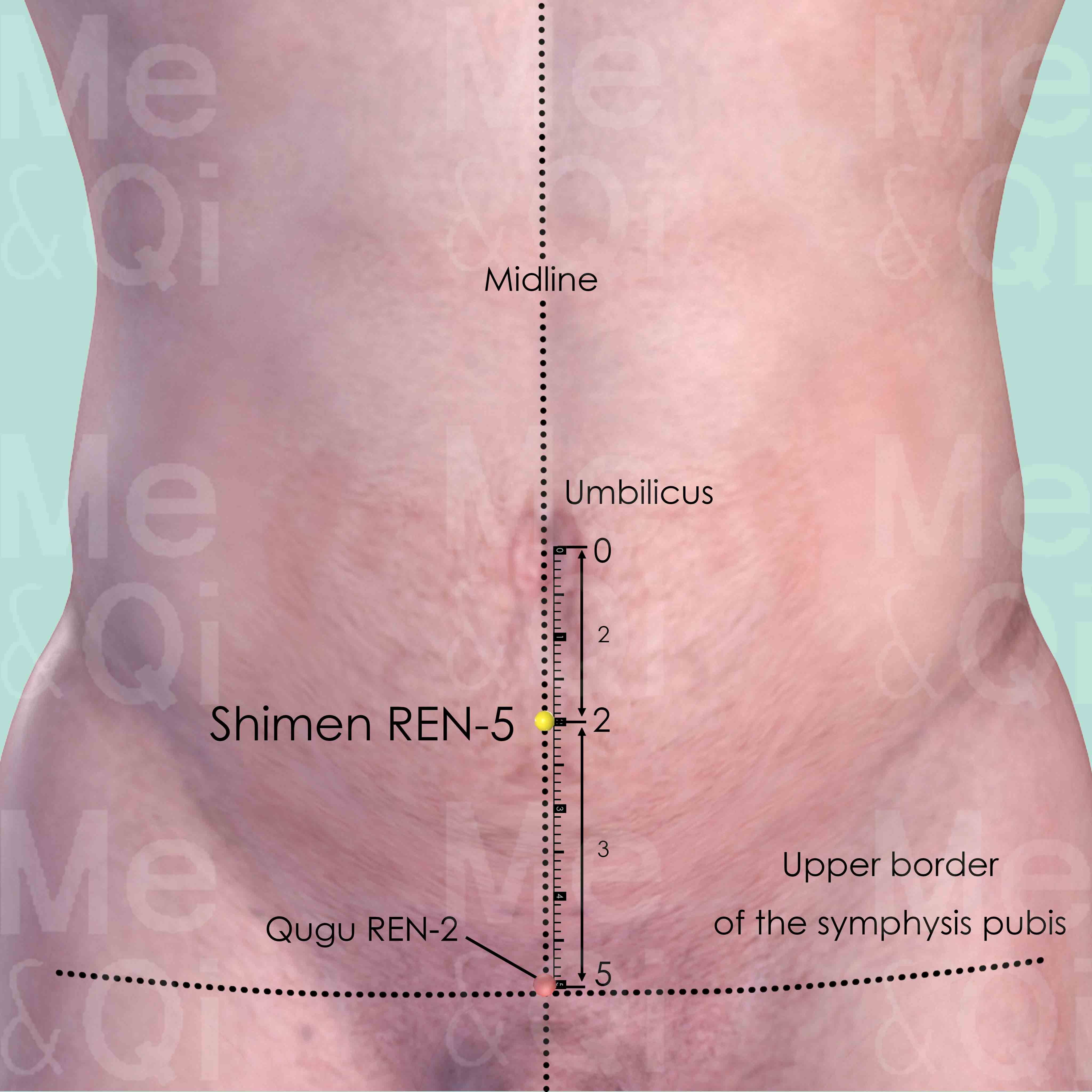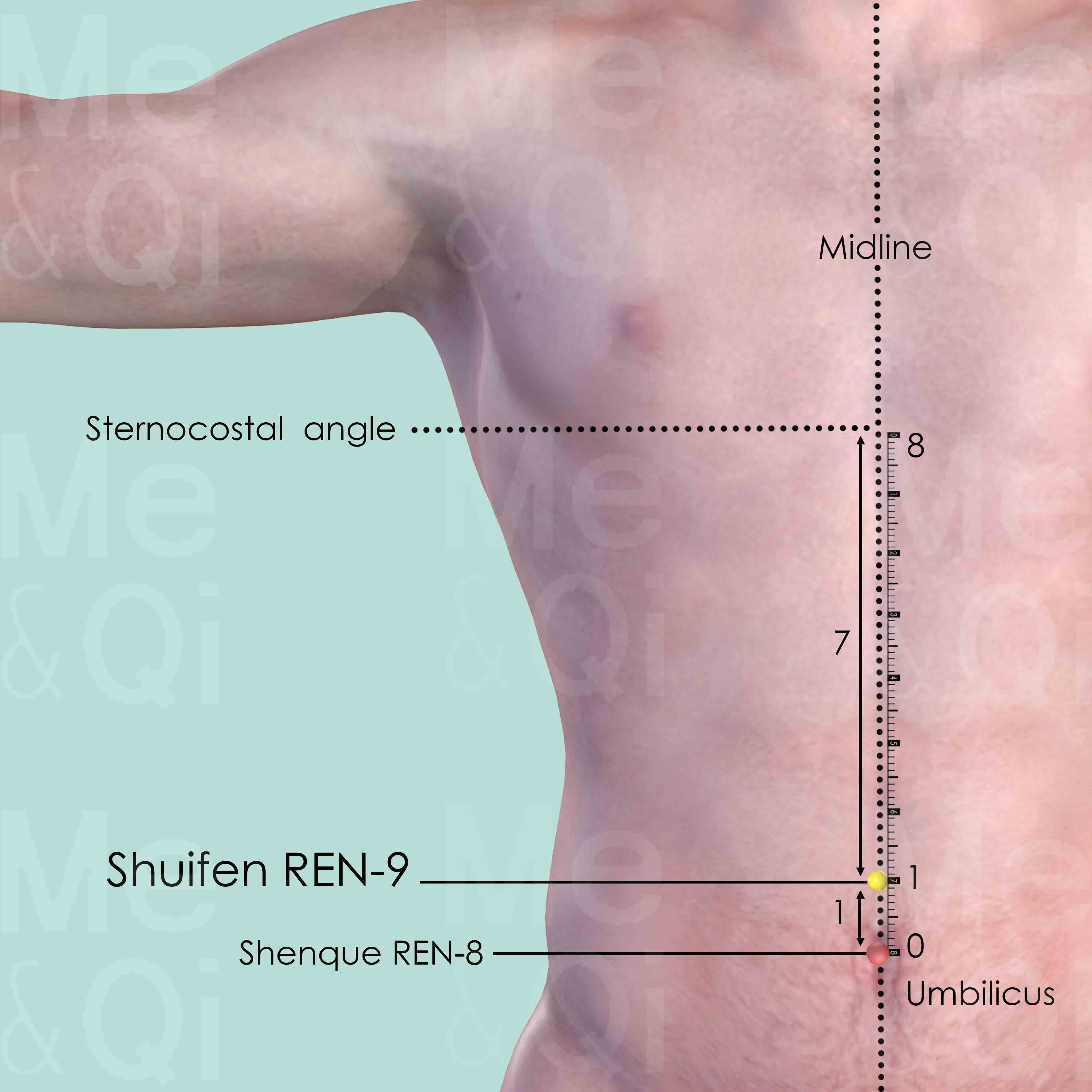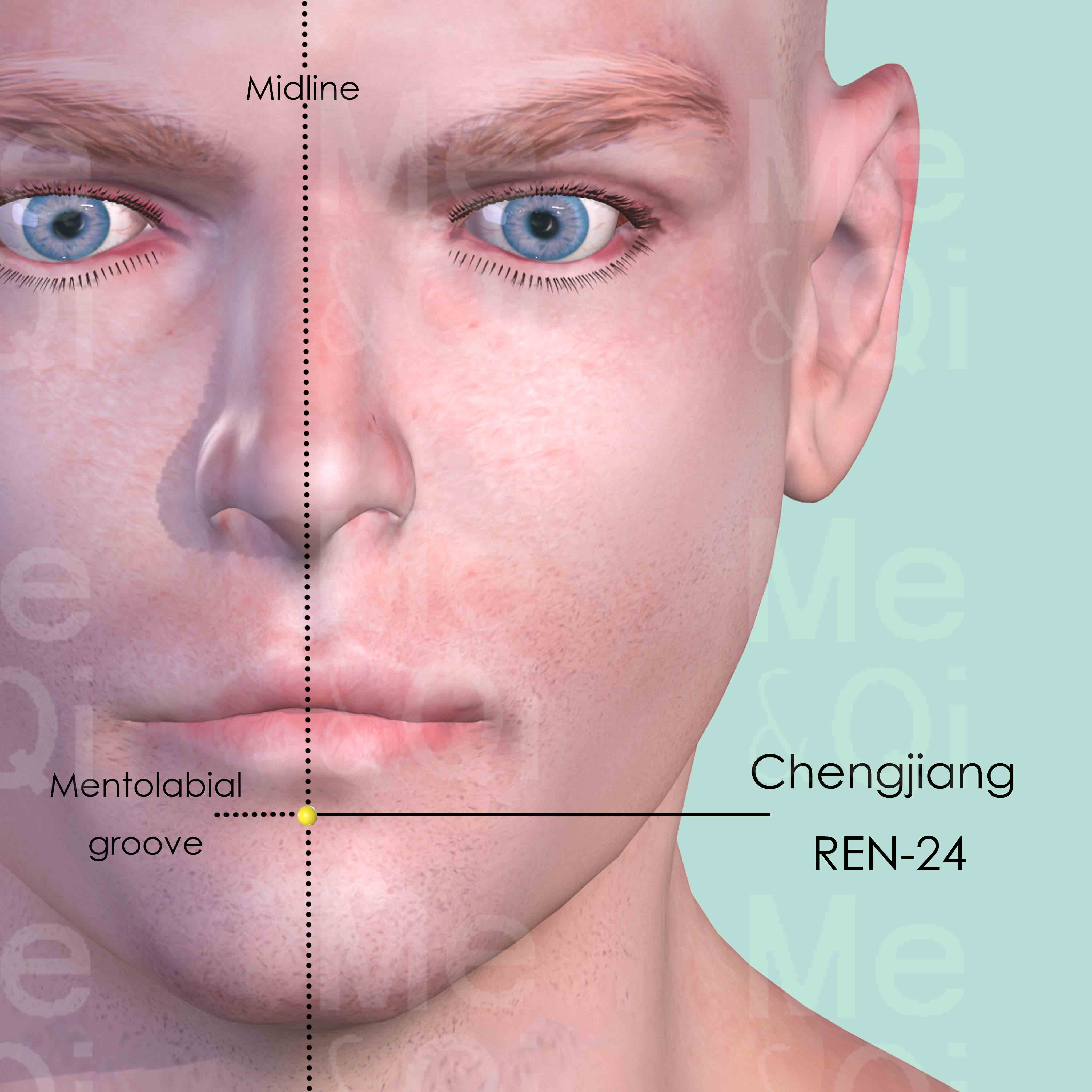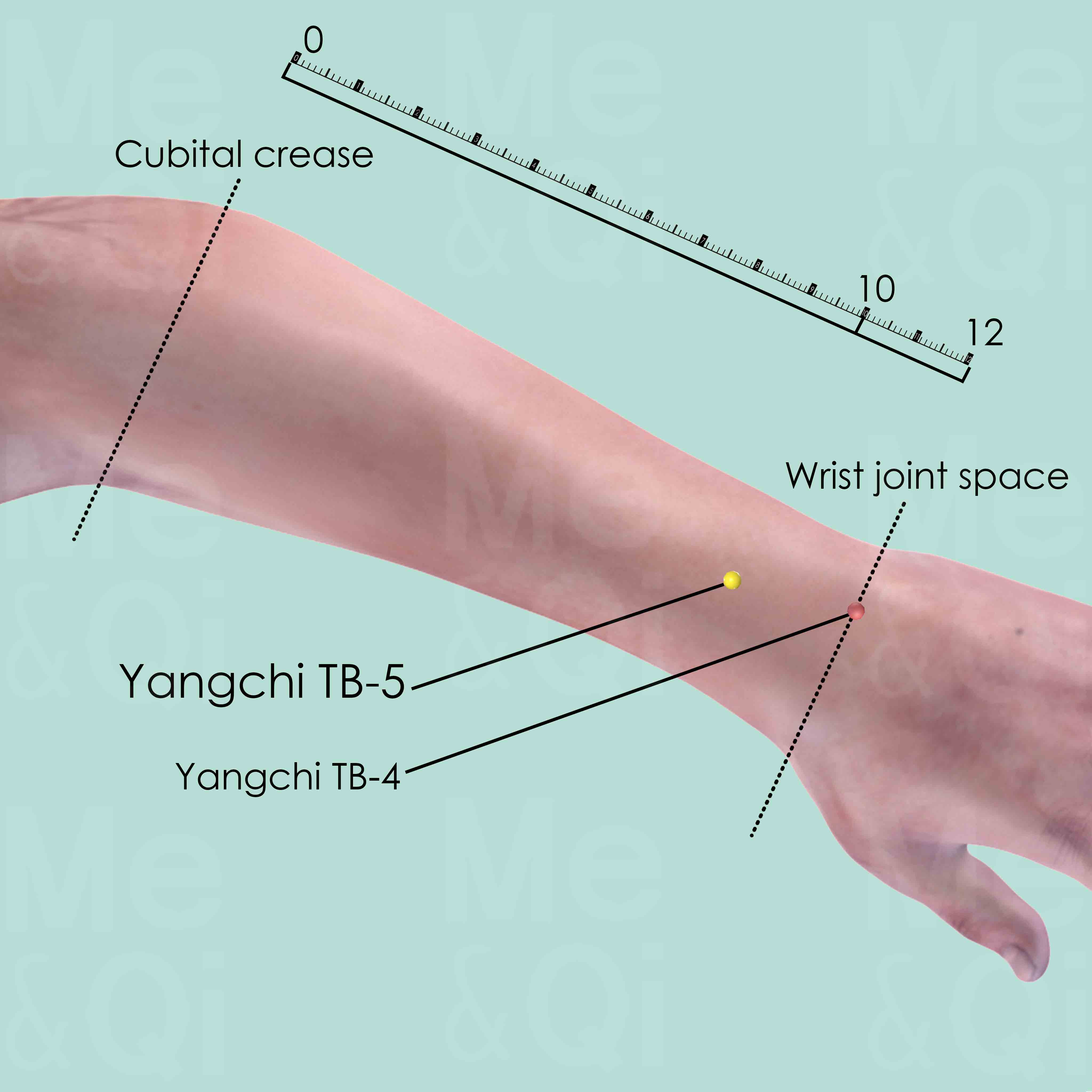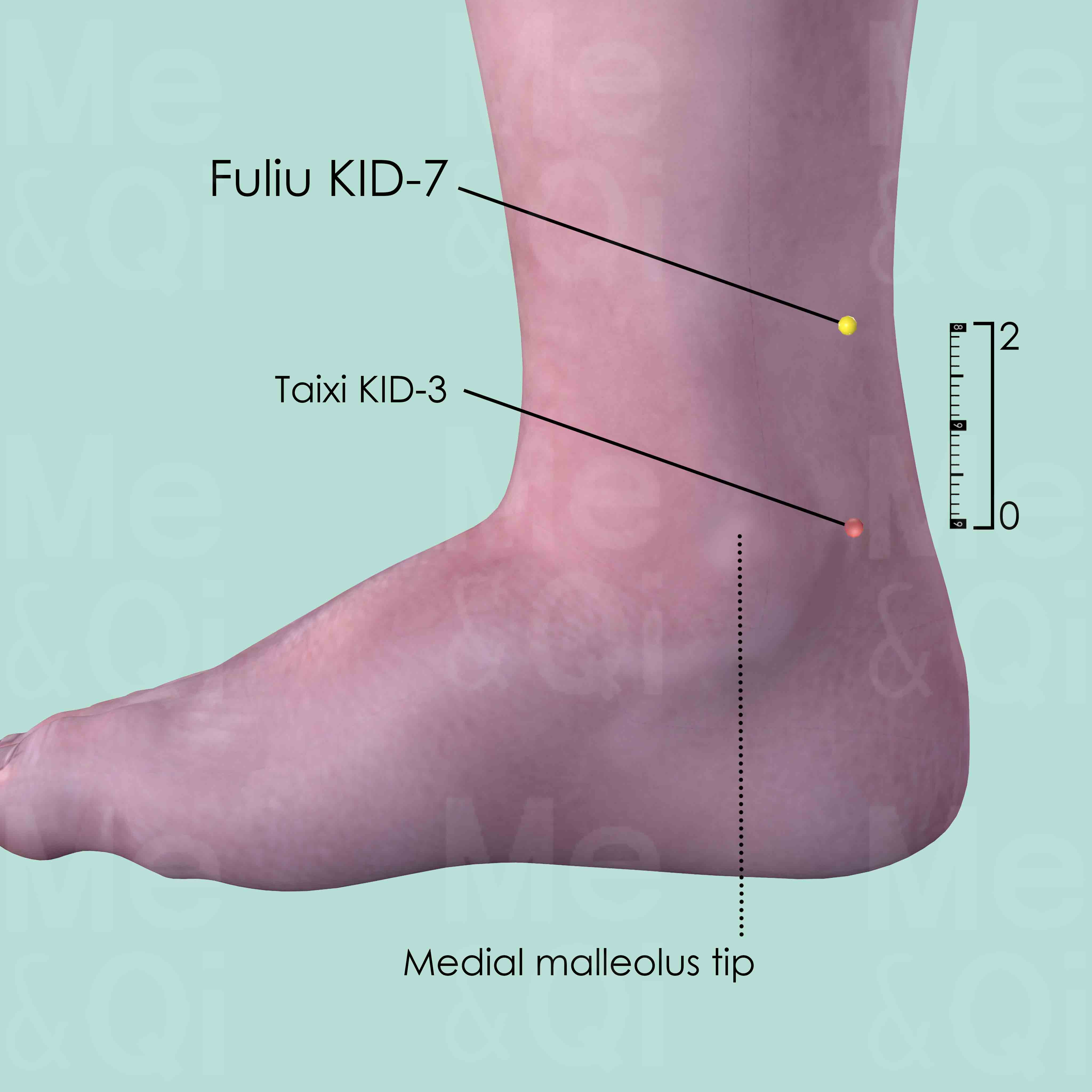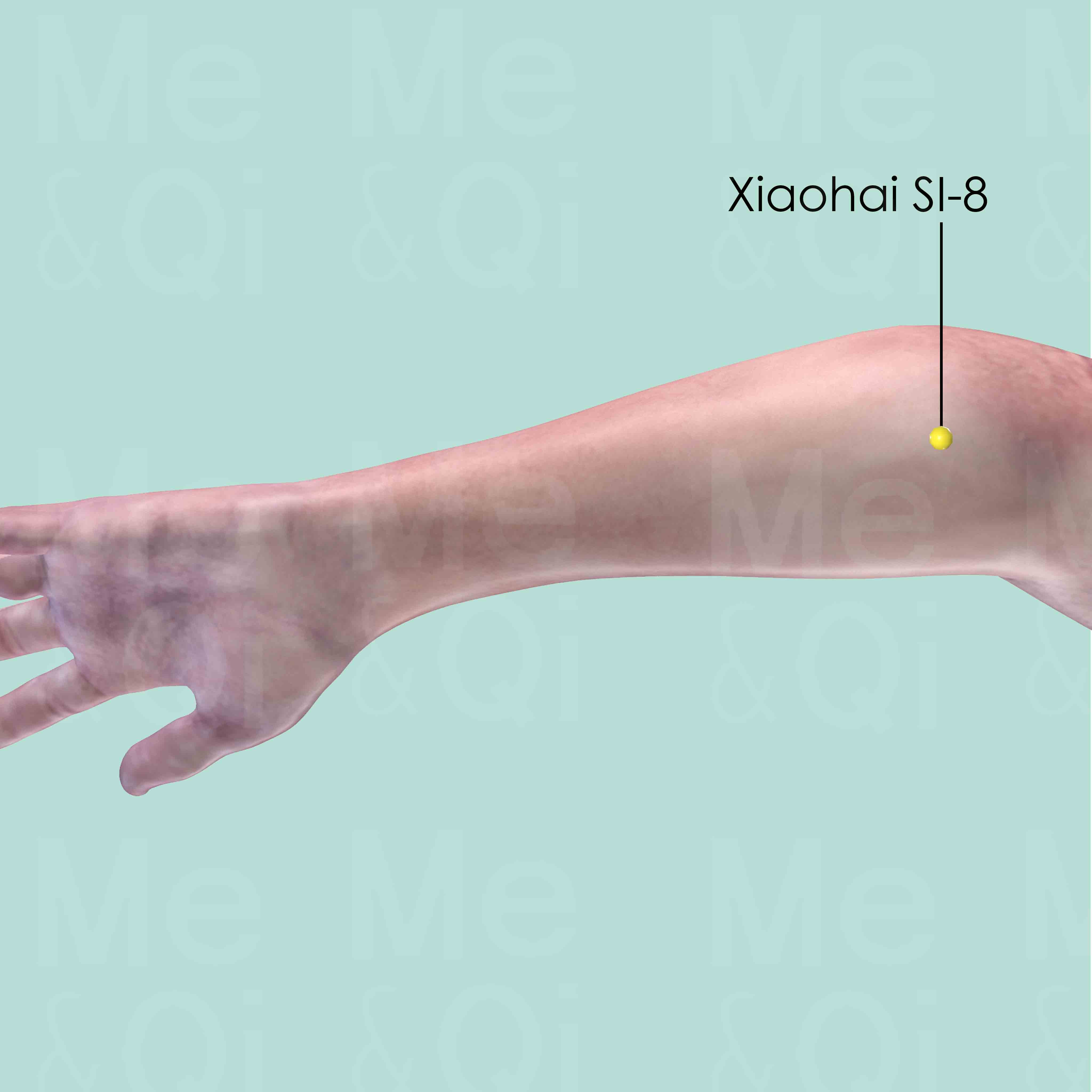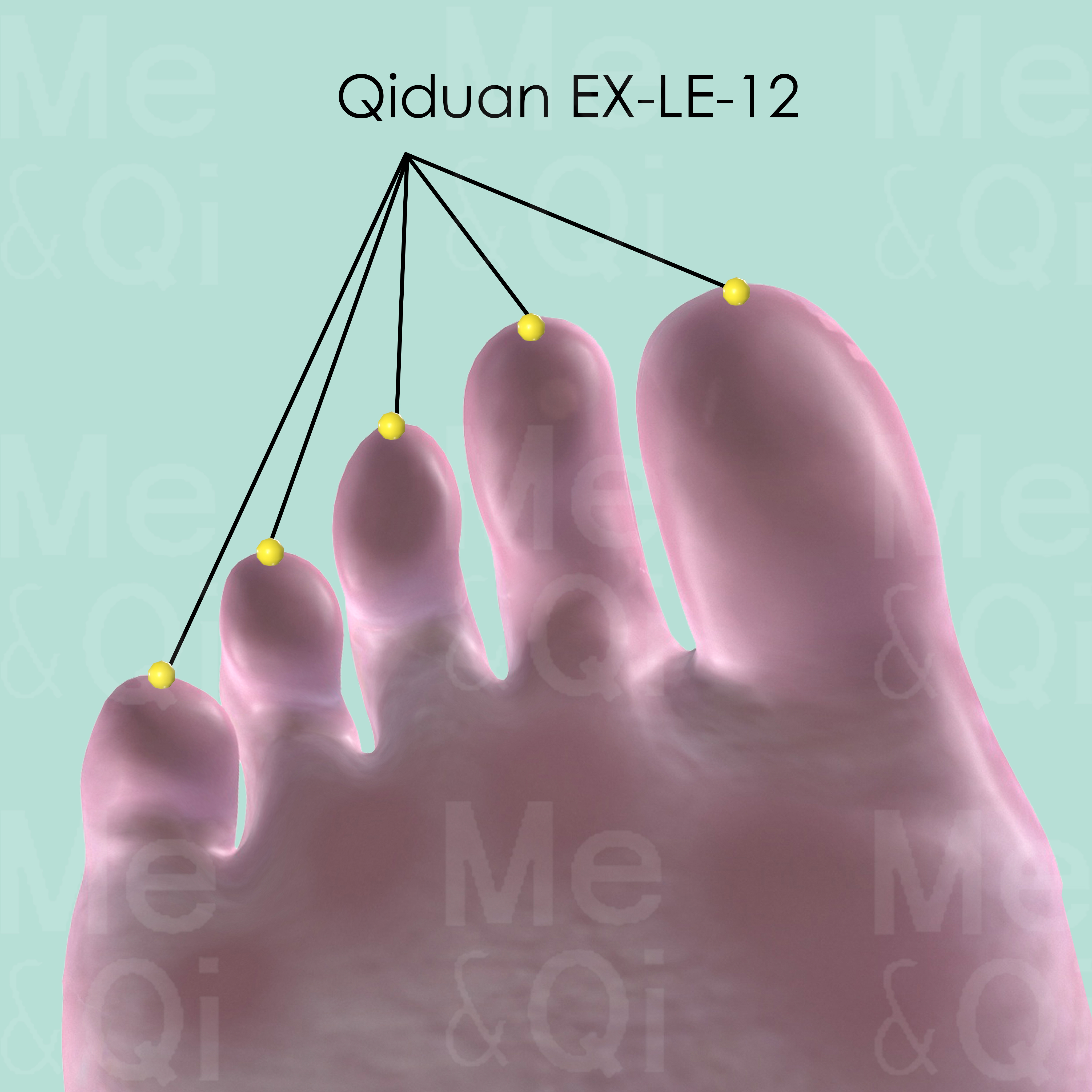Edemaaccording to TCM
Symptom family: Edema-associated Concerns
Sub-symptom(s): Menopausal Edema Ankle Edema Peripheral Edema Anasarca Lip Edema Vocal Cord Edema Malnutritional Edema Leg Edema Edema Of The Lower Extremities Idiopathic Edema Facial Edema Arm Swelling Abdominal Edema Acute Limb Edema Foot Edema Lymphedema
Did you mean? Anasarca
What is Edema?
Edema, known in layman's terms as fluid retention, swelling, or puffiness, manifests as an accumulation of fluid in the body's tissues, leading to noticeable swelling in various body parts. This condition can present in specific areas, such as the ankles (Ankle Edema), or affect the body more generally, as seen in conditions like anasarca (generalized body swelling). Other forms include Peripheral Edema, Lip Edema, and Facial Edema, each with its unique characteristics and underlying causes, ranging from systemic diseases to localized injuries or infections.
How Does TCM View Edema?
Traditional Chinese Medicine (TCM) offers a unique perspective on edema, attributing its cause to imbalances within the body's energy systems, particularly concerning the Spleen, Kidney, and the harmony between Qi and Blood. Unlike the Western medical approach, which often focuses on the symptom, TCM seeks to identify and treat the root cause of edema, emphasizing the importance of diagnosing the specific pattern of disharmony leading to fluid accumulation.
Root Causes of Edema in TCM
In TCM, the causes of edema are multifaceted and include imbalances such as Qi and Blood Deficiency, Yang Deficiency, Dampness, or Phlegm etc. Qi Deficiency, for instance, might manifest through symptoms like general weakness and breathlessness, indicating a weakened life force unable to contain bodily fluids properly.
On the other hand, Yang Deficiency, particularly of the Spleen and Kidney, leads to a failure in warming the body and transforming fluids, resulting in edema. Dampness, often due to Spleen dysfunction, results in the accumulation of fluids as the body fails to metabolize water correctly. Each pattern requires a distinct treatment approach within TCM, aiming to restore balance and eliminate the root cause of edema.
Explore below more details about what might cause Edema according to TCM.
- By Syndrome
- By Organ
- Dampness
- Phlegm
- Yang Deficiency
- Qi Deficiency
- Cold
- Wind
- Heat
- Blood Deficiency
- Yin Excess
- Qi Stagnation
- Blood Stasis
- View More Causes
- Spleen
- Kidney
- Uterus
- Lung
- Gallbladder
- View More Organs
Dampness
"Dampness" in TCM is a concept that describes a pattern of disharmony where the body accumulates excess moisture. Imagine the heavy, sticky feeling you get on a very humid day; that's similar to what dampness feels like internally. It can manifest as a sense of heaviness, bloating, sluggishness, or even a foggy mind. This condition is often thought to arise from environmental factors like living in a damp place, dietary habits that promote moisture in the body, or internal imbalances that hinder the body's ability to process fluids properly. In TCM, dampness can obstruct the normal flow of energy and fluids in the body, leading to various symptoms.... see more
Dampness Patterns That Can Lead to Edema
Common Symptoms: Generalized Fatigue Feeling Of Heaviness Diarrhea Shortness Of Breath Nausea Urinary Dysfunction Lack Of Appetite Absence Of Thirst
| Pattern Name | Relevant Symptoms | Relevant Formulas |
|---|---|---|
| Cold-Damp invading the Spleen | Edema, Lack of appetite, Epigastric coldness, Head and body heaviness, Sweet taste in mouth, Absence of thirst, Diarrhea, General weakness, Generalized fatigue, Nausea, Dull pale complexion, White vaginal discharge, Upper abdominal fullness... see more | Ping Wei San |
| Damp-Phlegm in the Uterus | Edema, Oedema, Late menstruation, Amenorrhea, Scanty menstruation, Lower abdominal pain, Abdominal heaviness, Feeling of oppression of the chest, Generalized fatigue, Diarrhea, Dull pale complexion, Obesity, Infertility, Ovarian cysts, Ovarian fibroids, Polycystic ovary syndrome, Pseudocyesis, Sputum, Feeling of heaviness... see more | Bu Zhong Yi Qi Tang | Xiong Gui Er Chen Tang | Xiang Sha Liu Jun Zi Tang | Cang Fu Dao Tan Wan |
| Oedema | Oedema of ankles, Oedema of legs, Oedema of face, Oedema of abdomen, Oedema of feet, Abdominal edema, Ankle edema, Facial edema, Foot edema, Oedema of hands, Leg edema, Ocular swelling, Abdominal distention... see more | Ping Wei San | Fang Ji Huang Qi Tang | Zhen Wu Tang | Wu Ling San | Wu Pi Yin | Ling Gui Zhu Gan Tang | Shen Qi Wan | Yu Gong San | Zhou Che Wan |
| Damp-Phlegm | Swollen limbs, Profuse white sputum, Focal distention of the chest, Upper abdominal focal distention, Nausea, Sticky taste in the mouth, Absence of thirst, Obesity, Abdominal fat... see more | Xiang Sha Liu Jun Zi Tang | Er Chen Tang | Shen Qi Wan |
| Kidney Yang Deficiency with Water overflowing | Oedema especially of the legs and ankles, Edema of the lower extremities, Cold sensation in legs and back, Abdominal distention, Lumbar pain, Chills, Scanty clear urination, Palpitations, Shortness of breath, Cold hands, White and watery sputum, Coughing, Asthma... see more | Ji Sheng Shen Qi Wan | Wu Ling San |
| Wind-Cold-Water invading the Lungs | Oedema of face, Ocular swelling, Shiny complexion, Scanty clear urination, Fever, Coughing, Shortness of breath, Aversion to cold, Facial edema... see more | Xiao Qing Long Tang |
| Damp-Heat in the Gallbladder | Swelling of the feet, Hypochondriac pain, Hypochondriac distention, Nausea or vomiting, Fat malabsorption, Dull yellow complexion, Scanty and dark urine, Fever, Dry mouth without desire to drink, Bitter taste in the mouth, Dizziness, Tinnitus, Irritability, Feeling of heaviness, Limb numbness, Foot edema, Alternating diarrhea and constipation, Alternating sensation of hot and cold, Yellow sclera... see more | Yin Chen Hao Tang |
| Wind-Damp | Edema, Perspiration, Feeling of heaviness, Urinary dysfunction, Ascites, Rheumatic heart disease, Rheumatoid arthritis, Acute glomerulonephritis, Lumbar disc disease... see more | Fang Ji Huang Qi Tang |
| Spleen Deficiency with Dampness | Edema, Feeling of heaviness, Diarrhea, Urinary dysfunction, Glomerulonephritis, Kidney infection, Nephrotic syndrome, Cystitis, Hydrocele, Migraine, Trigeminal neuralgia... see more | Wu Ling San |
Phlegm
In TCM "Phlegm" as a pattern of disharmony is a complex concept that extends beyond the physical manifestation of mucus. It represents a pathological factor that can disrupt the flow of Qi (vital energy) and blood, leading to various health issues. Phlegm in TCM is seen as a sticky, turbid substance arising from the body's inability to metabolize fluids properly, often due to a dysfunction of the spleen. It's not only associated with respiratory problems like cough and congestion but also with systemic issues. Symptoms can include a feeling of heaviness, mental cloudiness, dizziness, and in some cases, the formation of lumps or masses. Phlegm can even be "invisible," contributing to emotional disturbances like depression or stress. ... see more
Phlegm Patterns That Can Lead to Edema
Common Symptoms: Feeling Of Heaviness Generalized Fatigue Absence Of Thirst Feeling Of Oppression Of The Chest Obesity Chest Distension Dizziness Shortness Of Breath
| Pattern Name | Relevant Symptoms | Relevant Formulas |
|---|---|---|
| Damp-Phlegm in the Uterus | Edema, Oedema, Late menstruation, Amenorrhea, Scanty menstruation, Lower abdominal pain, Abdominal heaviness, Feeling of oppression of the chest, Generalized fatigue, Diarrhea, Dull pale complexion, Obesity, Infertility, Ovarian cysts, Ovarian fibroids, Polycystic ovary syndrome, Pseudocyesis, Sputum, Feeling of heaviness... see more | Bu Zhong Yi Qi Tang | Xiong Gui Er Chen Tang | Xiang Sha Liu Jun Zi Tang | Cang Fu Dao Tan Wan |
| Phlegm | Oedema, Feeling of oppression of the chest, Head fog, Dizziness | Yue Ju Wan | Wen Dan Tang | Ban Xia Hou Pu Tang |
| Phlegm-Fluids | Oedema, Abdominal distention, Vomiting clear liquid, Feeling of heaviness, Shortness of breath, Hypochondrial pain that is worse on coughing and breathing, Coughing, Lack of sweating, Absence of thirst, Edema, Chest distension... see more | Wu Ling San | Wen Dan Tang | Er Chen Tang | Ling Gui Zhu Gan Tang |
| Phlegm-Fluids above the diaphragm | Oedema, Coughing, Asthma, Edema, Feeling of oppression of the chest, Dizziness, Profuse white sputum... see more | Xiao Qing Long Tang | Ling Gan Wu Wei Jiang Xin Tang |
| Oedema | Oedema of ankles, Oedema of legs, Oedema of face, Oedema of abdomen, Oedema of feet, Abdominal edema, Ankle edema, Facial edema, Foot edema, Oedema of hands, Leg edema, Ocular swelling, Abdominal distention... see more | Ping Wei San | Fang Ji Huang Qi Tang | Zhen Wu Tang | Wu Ling San | Wu Pi Yin | Ling Gui Zhu Gan Tang | Shen Qi Wan | Yu Gong San | Zhou Che Wan |
| Phlegm-Fluids in the limbs | Superficial edema in the extremities, Swollen limbs, Feeling of heaviness, Muscle pain, Lack of sweating, Absence of thirst, Profuse white sputum, Urinary dysfunction... see more | Xiao Qing Long Tang | Da Qing Long Tang |
| Damp-Phlegm | Swollen limbs, Profuse white sputum, Focal distention of the chest, Upper abdominal focal distention, Nausea, Sticky taste in the mouth, Absence of thirst, Obesity, Abdominal fat... see more | Xiang Sha Liu Jun Zi Tang | Er Chen Tang | Shen Qi Wan |
Yang Deficiency
Yang deficiency in TCM refers to a state where the body's Yang energy, which is responsible for warmth, activity, and function, is weakened or diminished. This pattern of disharmony often arises from chronic illness, aging, or inherent constitutional weakness. Symptoms of Yang deficiency are typically associated with cold and sluggishness, such as a feeling of coldness, cold extremities, pale complexion, low energy or fatigue, and a desire for warmth. Digestive issues like poor appetite, loose stools, and water retention can also be indicative of Yang deficiency.... see more
Yang Deficiency Patterns That Can Lead to Edema
Common Symptoms: Chills Diarrhea Generalized Fatigue General Weakness Pale Face Cold Extremities Frequent Urination Lack Of Appetite
| Pattern Name | Relevant Symptoms | Relevant Formulas |
|---|---|---|
| Spleen Yang Deficiency | Edema, Slight abdominal distension after eating, General weakness, Desire to lie in fetal position, Pale face, Cold extremities, Chills, Undigested food in stools, Excessive gas and flatulence, Bloated abdomen, Abdominal pain relieved by pressure and warmth, Dull shallow face... see more | Bu Zhong Yi Qi Tang | Yi Huang Tang | Zhen Wu Tang | Huang Tu Tang |
| Yang Deficiency or Empty Yang | Edema, Chills, General cold feeling, Pale urine, Undigested food in stools, General weakness, Abdominal pain relieved by pressure and warmth, Frequent urination, Polyuria, Nocturia, White vaginal discharge... see more | Ba Wei Di Huang Wan | You Gui Wan |
| Kidney Yang Deficiency | Oedema of ankles, Oedema of legs, Edema of the lower extremities, Lower back pain, Dizziness, Tinnitus, Weak and cold knees, Lower back coldness, Chills, Weak legs, Bright pale face, Generalized fatigue, General weakness, Leg edema, Female infertility, Diarrhea, Depression, Erectile dysfunction, Premature ejaculation, Oligospermia, Low sex drive, Pale and abudant urination... see more | Ba Wei Di Huang Wan | You Gui Wan | Shen Qi Wan | Er Xian Tang | Wu Zi Yan Zong Wan | Tu Si Zi Wan |
| Kidney and Spleen Yang Deficiency | Oedema of legs, Lower back pain, Weak and cold knees, Back cold sensation, Chills, Weak legs, Bright pale face, Erectile dysfunction, Premature ejaculation, Oligospermia, Watery ejaculate, Low sex drive, Generalized fatigue, General weakness, Clear urination, Nocturia, Apathy, Leg edema, Female infertility, Diarrhea, Depression, Lack of appetite, Slight abdominal distention, Desire to lie down... see more | Li Zhong Wan |
| Kidney Yang Deficiency with Water overflowing | Oedema especially of the legs and ankles, Edema of the lower extremities, Cold sensation in legs and back, Abdominal distention, Lumbar pain, Chills, Scanty clear urination, Palpitations, Shortness of breath, Cold hands, White and watery sputum, Coughing, Asthma... see more | Ji Sheng Shen Qi Wan | Wu Ling San |
| Spleen or Kidney Yang Deficiency | Edema, Abdominal pain that worsens with cold, Urinary dysfunction, Deep pain and heaviness in limbs, Dizziness, Heavy sensation in the head, Diarrhea, Palpitations, Coughing, Vomit, Congestive heart failure... see more | Zhen Wu Tang |
| Spleen and Kidney Yang Deficiency | Oedema of limbs, Oedema of face, Pale face, Facial edema, Abdominal distention, Cold extremities, Shortness of breath, Diarrhea, Frequent urination, Lupus... see more | Wu Ling San |
Qi Deficiency
Qi Deficiency in TCM is like running low on battery power. Qi is the vital energy that powers every function in your body. When there's a Qi Deficiency, it means your body doesn't have enough of this essential energy. This can make you feel tired all the time, weak, or even cause shortness of breath. It's similar to how you feel when you haven't had enough sleep or nutritious food. Your body just doesn't have the energy it needs to perform at its best. Unlike modern medicine, which often focuses on specific physical causes for fatigue and weakness, TCM views Qi Deficiency as an overall energy depletion that affects your entire well-being, and it seeks to replenish and balance this vital energy.... see more
Qi Deficiency Patterns That Can Lead to Edema
Common Symptoms: Generalized Fatigue Diarrhea Sticky Vaginal Discharge Depression White Vaginal Discharge Lack Of Appetite Amenorrhea Back Pain
| Pattern Name | Relevant Symptoms | Relevant Formulas |
|---|---|---|
| Qi and Blood Deficiency | Edema, General weakness, Generalized fatigue, Weak voice, Pale face, Shortness of breath, Palpitations, Dizziness, Poor memory, Insomnia, Reluctance to speak, Lack of appetite, Limb numbness, Skin numbness... see more | Ba Zhen Yi Mu Tang | Sheng Yu Tang |
| Spleen Deficiency | Edema, Sticky vaginal discharge, Generalized fatigue, Depression, Cold extremities, Diarrhea, White vaginal discharge, Lack of appetite, Amenorrhea, Dull shallow face, Weak limbs... see more | Wan Dai Tang | Bu Zhong Yi Qi Tang | Yi Huang Tang |
| Spleen Deficiency with Dampness | Edema, Feeling of heaviness, Diarrhea, Urinary dysfunction, Glomerulonephritis, Kidney infection, Nephrotic syndrome, Cystitis, Hydrocele, Migraine, Trigeminal neuralgia... see more | Wu Ling San |
Cold
In TCM "Cold" as a pattern of disharmony refers to a specific type of imbalance within the body's systems, often linked to a deficiency or weakness. It's not about feeling physically cold or having a common cold, but rather a metaphorical description of certain symptoms and underlying conditions. When a TCM practitioner says someone suffers from "Cold," it usually implies that the body's Yang energy, which is warm and active, is insufficient or overpowered by Yin energy, which is cool and passive. Symptoms of Cold in TCM can include a general feeling of coldness, cold limbs, pale complexion, low energy, slow metabolism, and a preference for warmth. ... see more
Cold Patterns That Can Lead to Edema
Common Symptoms: Lack Of Appetite Epigastric Coldness Head And Body Heaviness Sweet Taste In Mouth Absence Of Thirst Diarrhea General Weakness Generalized Fatigue
| Pattern Name | Relevant Symptoms | Relevant Formulas |
|---|---|---|
| Cold-Damp invading the Spleen | Edema, Lack of appetite, Epigastric coldness, Head and body heaviness, Sweet taste in mouth, Absence of thirst, Diarrhea, General weakness, Generalized fatigue, Nausea, Dull pale complexion, White vaginal discharge, Upper abdominal fullness... see more | Ping Wei San |
| Wind-Cold-Water invading the Lungs | Oedema of face, Ocular swelling, Shiny complexion, Scanty clear urination, Fever, Coughing, Shortness of breath, Aversion to cold, Facial edema... see more | Xiao Qing Long Tang |
Wind
In TCM "Wind" is a concept that represents a pattern of disharmony, often characterized by its sudden and unpredictable nature, much like a gusty wind changing direction without warning. This pattern is associated with symptoms that come and go quickly or move around the body, such as itching, tremors, or even certain types of pain. Wind is considered to be a primary cause of illnesses that have these rapidly changing characteristics. In TCM, external Wind often refers to illnesses that start suddenly, like the common cold, believed to be caused by external pathogenic factors like climatic changes. On the other hand, internal Wind can be linked to internal imbalances and can manifest in conditions like dizziness or spasms. ... see more
Wind Patterns That Can Lead to Edema
Common Symptoms: Perspiration Feeling Of Heaviness Urinary Dysfunction Ascites Rheumatic Heart Disease Rheumatoid Arthritis Acute Glomerulonephritis Lumbar Disc Disease
| Pattern Name | Relevant Symptoms | Relevant Formulas |
|---|---|---|
| Wind-Cold-Water invading the Lungs | Oedema of face, Ocular swelling, Shiny complexion, Scanty clear urination, Fever, Coughing, Shortness of breath, Aversion to cold, Facial edema... see more | Xiao Qing Long Tang |
| Wind-Damp | Edema, Perspiration, Feeling of heaviness, Urinary dysfunction, Ascites, Rheumatic heart disease, Rheumatoid arthritis, Acute glomerulonephritis, Lumbar disc disease... see more | Fang Ji Huang Qi Tang |
Heat
In TCM "Heat" signifies an excess of Yang energy, leading to an imbalance where heat predominates over the body's cool Yin aspects. This condition is metaphorically akin to an internal over-heating. Symptoms indicative of Heat can include feelings of warmth, fever, sweating, irritability, red face, thirst with a preference for cold drinks, and a rapid pulse. The tongue may appear red with a yellow coating. Unlike the common interpretation of heat in terms of temperature, in TCM, it represents a state of hyperactivity or inflammation in the body.... see more
Heat Patterns That Can Lead to Edema
Common Symptoms: Fever Pus And Discharge Boils Carbuncles Pustule Red Skin Eruptions Sore Throat Eczema
| Pattern Name | Relevant Symptoms | Relevant Formulas |
|---|---|---|
| Toxic-Heat | Swellings, Fever, Edema, Pus and discharge, Boils, Carbuncles, Pustule, Red skin eruptions, Sore throat, Eczema, Perineum swollen, Prostate swollen, Testicular swelling, Mouth ulcers, Tonsil swelling... see more | Yin Qiao San | Sang Ju Yin | Bai Hu Tang | Long Dan Xie Gan Tang | Qing Ying Tang | Xi Jiao Di Huang Tang | Huang Lian Jie Du Tang | Xin Yi Qing Fei Yin | Gan Lu Xiao Du Dan | Shi Wei Bai Du San | San Zhong Kui Jian Tang | Zi Dang Gao | Er Qing Gao | Bing Peng San | Pu Ji Xiao Du Yin | Wu Wei Xiao Du Yin |
| Damp-Heat in the Gallbladder | Swelling of the feet, Hypochondriac pain, Hypochondriac distention, Nausea or vomiting, Fat malabsorption, Dull yellow complexion, Scanty and dark urine, Fever, Dry mouth without desire to drink, Bitter taste in the mouth, Dizziness, Tinnitus, Irritability, Feeling of heaviness, Limb numbness, Foot edema, Alternating diarrhea and constipation, Alternating sensation of hot and cold, Yellow sclera... see more | Yin Chen Hao Tang |
Blood Deficiency
Blood Deficiency in TCM is like when your body's tank runs low on the vital energy that blood provides. It's not exactly the same as anemia in modern medicine, which is about having too few red blood cells. Instead, Blood Deficiency in TCM is about your body not having enough of the life-giving qualities that blood brings, like nourishment and moisture. This can make you feel tired, look pale, and even feel dizzy or have blurry vision. It's like a garden not getting enough water to stay lush and vibrant. TCM sees this as an imbalance where the body isn't being nourished as it should be, impacting overall health and well-being.... see more
Blood Deficiency Patterns That Can Lead to Edema
| Pattern Name | Relevant Symptoms | Relevant Formulas |
|---|---|---|
| Qi and Blood Deficiency | Edema, General weakness, Generalized fatigue, Weak voice, Pale face, Shortness of breath, Palpitations, Dizziness, Poor memory, Insomnia, Reluctance to speak, Lack of appetite, Limb numbness, Skin numbness... see more | Ba Zhen Yi Mu Tang | Sheng Yu Tang |
Yin Excess
Yin Excess in TCM is a pattern of disharmony characterized by an overabundance of Yin energy, leading to symptoms of dampness and coldness in the body. This condition often results from an imbalance where the cooling, moistening aspects of Yin overshadow the warm, active qualities of Yang energy. Symptoms can include a feeling of heaviness, lethargy, cold sensations, pale complexion, and possibly edema or fluid retention. Digestive issues such as poor appetite, bloating, and loose stools may also be present, reflecting the impact of excess Yin on the body's metabolic processes. Treatment in TCM for Yin Excess focuses on reducing the excess Yin and stimulating Yang energy to restore balance. ... see more
Yin Excess Patterns That Can Lead to Edema
| Pattern Name | Relevant Symptoms | Relevant Formulas |
|---|---|---|
| Yin Excess | Edema, Absence of thirst, Slow and forceful movement, Epigastric pain worsen by pressure, Polyuria, Feeling of oppression of the chest, Nausea, Excessive vaginal discharge, Lack of appetite, Pain relieved by heat, Chills, Cold extremities, Pale urine... see more | Wu Ling San | Wu Pi Yin |
Qi Stagnation
Qi Stagnation in TCM is like having a traffic jam in your body's energy system. Qi, the vital life force that flows through your body, is supposed to move smoothly to maintain health and balance. But with Qi Stagnation, this flow gets blocked or slowed down, like cars stuck on a highway. This can lead to symptoms like feeling stressed, emotional mood swings, and physical discomfort, often described as a feeling of fullness or tightness, especially in the chest or abdomen. It's as though the body's internal energy circulation is disrupted, causing various issues. TCM sees this as an energy flow problem, different from modern medicine's focus on specific physiological processes.... see more
Qi Stagnation Patterns That Can Lead to Edema
| Pattern Name | Relevant Symptoms | Relevant Formulas |
|---|---|---|
| Qi And Blood Stagnation | Swelling of the feet, Chest distension, Chest pain, Stabbing fixed pain, Dark face, Purple lips, Purple nails, Irritability, Mood swings, Depression, Mottled skin, Foot edema, Abdominal masses, Melena black tarry stool, Menstrual cramps, Amenorrhea, Dark menstrual clots, Dark menstrual blood, Prolonged lochia, Irregular periods... see more | Xue Fu Zhu Yu Tang | Shen Tong Zhu Yu Tang | Shao Fu Zhu Yu Tang | Ge Xia Zhu Yu Tang | Chai Hu Shu Gan San | Shi Xiao San | Qi Li San | Dan Shen Yin | Guo Qi Yin |
Blood Stasis
Blood Stasis in TCM is a concept where the blood flow in the body is not as smooth or efficient as it should be. Imagine a river that's supposed to flow freely, but instead, it's getting blocked or moving too slowly in some parts. This can lead to various health issues, like pain that feels sharp or stabbing, dark bruises, and a complexion that looks purplish. TCM believes that good health relies on the smooth and vibrant flow of Qi and blood throughout the body, so when blood gets stuck, it's like a traffic jam in your body, leading to discomfort or health problems.... see more
Blood Stasis Patterns That Can Lead to Edema
| Pattern Name | Relevant Symptoms | Relevant Formulas |
|---|---|---|
| Qi And Blood Stagnation | Swelling of the feet, Chest distension, Chest pain, Stabbing fixed pain, Dark face, Purple lips, Purple nails, Irritability, Mood swings, Depression, Mottled skin, Foot edema, Abdominal masses, Melena black tarry stool, Menstrual cramps, Amenorrhea, Dark menstrual clots, Dark menstrual blood, Prolonged lochia, Irregular periods... see more | Xue Fu Zhu Yu Tang | Shen Tong Zhu Yu Tang | Shao Fu Zhu Yu Tang | Ge Xia Zhu Yu Tang | Chai Hu Shu Gan San | Shi Xiao San | Qi Li San | Dan Shen Yin | Guo Qi Yin |
Spleen
In TCM the Spleen plays a vital role in digestion and transformation, converting food into energy and nutrients, and overseeing the distribution of Qi and Blood. It's also crucial in maintaining the health of muscles and limbs and ensuring the blood remains within the vessels. When the Spleen malfunctions in TCM, it can lead to a variety of issues such as digestive disorders, fatigue, weak muscles, bloating, and a feeling of heaviness. It can also cause a pale complexion, poor appetite, and a tendency to bruise easily. Emotionally, a Spleen imbalance is often associated with excessive worry or overthinking, reflecting its role in the interplay between physical and mental health.... see more
Spleen Patterns That Can Lead to Edema
Common Symptoms: Diarrhea Generalized Fatigue Lack Of Appetite Depression Cold Extremities White Vaginal Discharge General Weakness Chills
| Pattern Name | Relevant Symptoms | Relevant Formulas |
|---|---|---|
| Cold-Damp invading the Spleen | Edema, Lack of appetite, Epigastric coldness, Head and body heaviness, Sweet taste in mouth, Absence of thirst, Diarrhea, General weakness, Generalized fatigue, Nausea, Dull pale complexion, White vaginal discharge, Upper abdominal fullness... see more | Ping Wei San |
| Spleen Yang Deficiency | Edema, Slight abdominal distension after eating, General weakness, Desire to lie in fetal position, Pale face, Cold extremities, Chills, Undigested food in stools, Excessive gas and flatulence, Bloated abdomen, Abdominal pain relieved by pressure and warmth, Dull shallow face... see more | Bu Zhong Yi Qi Tang | Yi Huang Tang | Zhen Wu Tang | Huang Tu Tang |
| Kidney and Spleen Yang Deficiency | Oedema of legs, Lower back pain, Weak and cold knees, Back cold sensation, Chills, Weak legs, Bright pale face, Erectile dysfunction, Premature ejaculation, Oligospermia, Watery ejaculate, Low sex drive, Generalized fatigue, General weakness, Clear urination, Nocturia, Apathy, Leg edema, Female infertility, Diarrhea, Depression, Lack of appetite, Slight abdominal distention, Desire to lie down... see more | Li Zhong Wan |
| Spleen Deficiency | Edema, Sticky vaginal discharge, Generalized fatigue, Depression, Cold extremities, Diarrhea, White vaginal discharge, Lack of appetite, Amenorrhea, Dull shallow face, Weak limbs... see more | Wan Dai Tang | Bu Zhong Yi Qi Tang | Yi Huang Tang |
| Spleen Deficiency with Dampness | Edema, Feeling of heaviness, Diarrhea, Urinary dysfunction, Glomerulonephritis, Kidney infection, Nephrotic syndrome, Cystitis, Hydrocele, Migraine, Trigeminal neuralgia... see more | Wu Ling San |
| Spleen or Kidney Yang Deficiency | Edema, Abdominal pain that worsens with cold, Urinary dysfunction, Deep pain and heaviness in limbs, Dizziness, Heavy sensation in the head, Diarrhea, Palpitations, Coughing, Vomit, Congestive heart failure... see more | Zhen Wu Tang |
| Spleen and Kidney Yang Deficiency | Oedema of limbs, Oedema of face, Pale face, Facial edema, Abdominal distention, Cold extremities, Shortness of breath, Diarrhea, Frequent urination, Lupus... see more | Wu Ling San |
Kidney
In TCM the Kidneys are regarded as the body's most fundamental reservoir of Essence, known as Jing, which influences growth, reproduction, and aging. They are not just organs for filtering blood, but a holistic system governing vital life forces. When the Kidneys malfunction in TCM, it can manifest as a variety of health issues, such as chronic fatigue, reproductive problems, imbalances in fluid metabolism leading to edema or dryness, lower back pain, and a sense of fear or insecurity.... see more
Kidney Patterns That Can Lead to Edema
Common Symptoms: Diarrhea Chills Dizziness Coughing Tinnitus Generalized Fatigue Depression Frequent Urination
| Pattern Name | Relevant Symptoms | Relevant Formulas |
|---|---|---|
| Kidney Yang Deficiency | Oedema of ankles, Oedema of legs, Edema of the lower extremities, Lower back pain, Dizziness, Tinnitus, Weak and cold knees, Lower back coldness, Chills, Weak legs, Bright pale face, Generalized fatigue, General weakness, Leg edema, Female infertility, Diarrhea, Depression, Erectile dysfunction, Premature ejaculation, Oligospermia, Low sex drive, Pale and abudant urination... see more | Ba Wei Di Huang Wan | You Gui Wan | Shen Qi Wan | Er Xian Tang | Wu Zi Yan Zong Wan | Tu Si Zi Wan |
| Kidney and Spleen Yang Deficiency | Oedema of legs, Lower back pain, Weak and cold knees, Back cold sensation, Chills, Weak legs, Bright pale face, Erectile dysfunction, Premature ejaculation, Oligospermia, Watery ejaculate, Low sex drive, Generalized fatigue, General weakness, Clear urination, Nocturia, Apathy, Leg edema, Female infertility, Diarrhea, Depression, Lack of appetite, Slight abdominal distention, Desire to lie down... see more | Li Zhong Wan |
| Kidney Yang Deficiency with Water overflowing | Oedema especially of the legs and ankles, Edema of the lower extremities, Cold sensation in legs and back, Abdominal distention, Lumbar pain, Chills, Scanty clear urination, Palpitations, Shortness of breath, Cold hands, White and watery sputum, Coughing, Asthma... see more | Ji Sheng Shen Qi Wan | Wu Ling San |
| Kidneys failing to receive Qi | Swelling of the face, Exertional dyspnea, Rapid respiration, Weak respiratory, Difficulty breathing in, Chronic coughing, Asthma, Spontaneous sweat, Cold extremities, Facial edema, Emaciation, Low energy, Lower back pain, Dizziness, Tinnitus, Clear urination... see more | You Gui Wan | Su Zi Jiang Qi Tang | Ren Shen Ge Jie San |
| Spleen or Kidney Yang Deficiency | Edema, Abdominal pain that worsens with cold, Urinary dysfunction, Deep pain and heaviness in limbs, Dizziness, Heavy sensation in the head, Diarrhea, Palpitations, Coughing, Vomit, Congestive heart failure... see more | Zhen Wu Tang |
| Spleen and Kidney Yang Deficiency | Oedema of limbs, Oedema of face, Pale face, Facial edema, Abdominal distention, Cold extremities, Shortness of breath, Diarrhea, Frequent urination, Lupus... see more | Wu Ling San |
Uterus
In TCM the Uterus (or "Bao Gong") is not just a reproductive organ but a vital system closely linked to Kidney energy, responsible for menstrual health, fertility, and pregnancy. It's also connected to the Heart and Liver, reflecting the importance of emotional and blood health in reproductive wellness. In TCM, the Uterus is seen as a reservoir of Blood and Qi, crucial for reproductive health and general vitality. When the Uterus malfunctions or is imbalanced, it can lead to menstrual irregularities, infertility, miscarriages, or menopausal symptoms. Additionally, there might be symptoms like lower abdominal pain or emotional disturbances such as mood swings, often linked to Liver Qi stagnation. These manifestations highlight the TCM perspective that the health of the Uterus is intertwined with the overall balance of energy and blood in the body, as well as emotional well-being.... see more
Uterus Patterns That Can Lead to Edema
| Pattern Name | Relevant Symptoms | Relevant Formulas |
|---|---|---|
| Damp-Phlegm in the Uterus | Edema, Oedema, Late menstruation, Amenorrhea, Scanty menstruation, Lower abdominal pain, Abdominal heaviness, Feeling of oppression of the chest, Generalized fatigue, Diarrhea, Dull pale complexion, Obesity, Infertility, Ovarian cysts, Ovarian fibroids, Polycystic ovary syndrome, Pseudocyesis, Sputum, Feeling of heaviness... see more | Bu Zhong Yi Qi Tang | Xiong Gui Er Chen Tang | Xiang Sha Liu Jun Zi Tang | Cang Fu Dao Tan Wan |
Lung
In TCM the Lungs are seen as the organ responsible for controlling Qi and respiration, as well as being a key part of the body's defensive system. They are thought to maintain the balance and flow of air and moisture, and are closely linked to the skin and hair. When the Lungs are imbalanced or malfunctioning in TCM, it can lead to respiratory issues like coughing or asthma, a weakened immune system, dry skin, and emotional disturbances such as sadness or grief. These symptoms are believed to arise from disruptions in the Lungs' ability to regulate Qi and protect the body, highlighting their central role in maintaining overall health and well-being.... see more
Lung Patterns That Can Lead to Edema
| Pattern Name | Relevant Symptoms | Relevant Formulas |
|---|---|---|
| Wind-Cold-Water invading the Lungs | Oedema of face, Ocular swelling, Shiny complexion, Scanty clear urination, Fever, Coughing, Shortness of breath, Aversion to cold, Facial edema... see more | Xiao Qing Long Tang |
Gallbladder
In TCM the Gallbladder has a unique role in storing and excreting bile, but more importantly, it's seen as crucial for decision-making and courage. It's closely connected to the Liver, assisting in the smooth flow of Qi (vital energy) and supporting the Liver's role in maintaining emotional balance. When the Gallbladder malfunctions or is imbalanced in TCM, it can lead to physical symptoms like gallstones, jaundice, or a bitter taste in the mouth. There might also be digestive disturbances, particularly related to fat metabolism. On an emotional level, a Gallbladder disorder can manifest as indecisiveness, timidity, or a tendency to easily succumb to stress. These symptoms highlight the TCM view of the Gallbladder as integral to both physical processes and emotional resilience.... see more
Gallbladder Patterns That Can Lead to Edema
| Pattern Name | Relevant Symptoms | Relevant Formulas |
|---|---|---|
| Damp-Heat in the Gallbladder | Swelling of the feet, Hypochondriac pain, Hypochondriac distention, Nausea or vomiting, Fat malabsorption, Dull yellow complexion, Scanty and dark urine, Fever, Dry mouth without desire to drink, Bitter taste in the mouth, Dizziness, Tinnitus, Irritability, Feeling of heaviness, Limb numbness, Foot edema, Alternating diarrhea and constipation, Alternating sensation of hot and cold, Yellow sclera... see more | Yin Chen Hao Tang |
TCM Herbal Formulas for Edema
TCM addresses edema through a variety of herbal formulas tailored to the underlying pattern of disharmony. For Qi Deficiency, formulas like Ba Zhen Yi Mu Tang, which tonifies both Qi and Blood, are commonly used. In cases of Yang Deficiency, treatments might include warming and tonifying formulas such as Ba Wei Di Huang Wan.
Dampness is treated with formulas like Ping Wei San, which transforms Dampness and harmonizes the Stomach. Each formula is carefully selected based on the individual's specific TCM diagnosis, ensuring a targeted and effective approach to treating edema.
Explore below some TCM herbal formulas used to address edema, organized by cause and by formula type.
- By Cause
- By Formula Type
- Dampness
- Phlegm
- Yang Deficiency
- Qi Deficiency
- Cold
- Wind
- Heat
- Blood Deficiency
- Yin Excess
- Qi Stagnation
- Blood Stasis
- View More Causes
- Formulas that invigorate blood and dispel blood stagnation
- Formulas that warm yang and tonify
- Formulas that dry dampness and transform phlegm
- External formulas for external disorders
- Formulas that tonify qi
- Formulas that promote urination and leach out dampness
- Formulas that promote qi movement
- Formulas that clear external abscesses and sores
- Formulas that secure irregular uterine bleeding and stop vaginal discharge
- Formulas that tonify blood
- Formulas that warm and transform water and dampness
- Formulas that clear wind-Cold
- Formulas that clear heat from the organs
- Formulas that clear nutritive-level heat
- Formulas that clear heat and resolve toxicity
- Formulas that clear heat and expel dampness
- Formulas that drive out excess water
- Formulas that nourish yin and tonify
- Formulas that transform dampness and harmonize stomach
- Formulas that dispel phlegm
- Formulas that tonify
- Formulas that stop bleeding
- Formulas that expel dampness
- Formulas that warm and transform phlegm-Cold
- Formulas that clear wind-Heat
- Formulas that clear qi-level heat
- Formulas that dispel wind-Damp
- Formulas that warm the middle and dispel cold
- Formulas that tonify yin and yang
- Formulas for a rebellious qi
- Formulas that regulate blood
Top Formula for Dampness:
Wu Ling San
Suitable for Dampness patterns that may cause edema, such as Spleen Deficiency with Dampness or Oedema
Learn moreAll Formulas Recommended for Edema Caused by Dampness
| Formula | Patterns Suitable For |
|---|---|
| Wu Ling San | Spleen Deficiency with Dampness, Oedema, Kidney Yang Deficiency with Water overflowing... see more |
| Shen Qi Wan | Oedema, Damp-Phlegm |
| Ping Wei San | Cold-Damp invading the Spleen, Oedema |
| Fang Ji Huang Qi Tang | Wind-Damp, Oedema |
| Xiang Sha Liu Jun Zi Tang | Damp-Phlegm in the Uterus, Damp-Phlegm |
| Bu Zhong Yi Qi Tang | Damp-Phlegm in the Uterus |
| Zhen Wu Tang | Oedema |
| Xiao Qing Long Tang | Wind-Cold-Water invading the Lungs |
| Wu Pi Yin | Oedema |
| Ling Gui Zhu Gan Tang | Oedema |
| Er Chen Tang | Damp-Phlegm |
| Xiong Gui Er Chen Tang | Damp-Phlegm in the Uterus |
| Cang Fu Dao Tan Wan | Damp-Phlegm in the Uterus |
| Yu Gong San | Oedema |
| Zhou Che Wan | Oedema |
| Ji Sheng Shen Qi Wan | Kidney Yang Deficiency with Water overflowing |
| Yin Chen Hao Tang | Damp-Heat in the Gallbladder |
Top Formula for Phlegm:
Wu Ling San
Suitable for Phlegm patterns that may cause edema, such as Phlegm-Fluids or Oedema
Learn moreAll Formulas Recommended for Edema Caused by Phlegm
| Formula | Patterns Suitable For |
|---|---|
| Wu Ling San | Phlegm-Fluids, Oedema |
| Xiao Qing Long Tang | Phlegm-Fluids above the diaphragm, Phlegm-Fluids in the limbs |
| Shen Qi Wan | Oedema, Damp-Phlegm |
| Xiang Sha Liu Jun Zi Tang | Damp-Phlegm in the Uterus, Damp-Phlegm |
| Wen Dan Tang | Phlegm, Phlegm-Fluids |
| Er Chen Tang | Phlegm-Fluids, Damp-Phlegm |
| Ling Gui Zhu Gan Tang | Phlegm-Fluids, Oedema |
| Bu Zhong Yi Qi Tang | Damp-Phlegm in the Uterus |
| Zhen Wu Tang | Oedema |
| Ping Wei San | Oedema |
| Fang Ji Huang Qi Tang | Oedema |
| Wu Pi Yin | Oedema |
| Xiong Gui Er Chen Tang | Damp-Phlegm in the Uterus |
| Cang Fu Dao Tan Wan | Damp-Phlegm in the Uterus |
| Yue Ju Wan | Phlegm |
| Ban Xia Hou Pu Tang | Phlegm |
| Ling Gan Wu Wei Jiang Xin Tang | Phlegm-Fluids above the diaphragm |
| Yu Gong San | Oedema |
| Zhou Che Wan | Oedema |
| Da Qing Long Tang | Phlegm-Fluids in the limbs |
Top Formula for Yang Deficiency:
Wu Ling San
Suitable for Yang Deficiency patterns that may cause edema, such as Spleen and Kidney Yang Deficiency or Kidney Yang Deficiency with Water overflowing
Learn moreAll Formulas Recommended for Edema Caused by Yang Deficiency
| Formula | Patterns Suitable For |
|---|---|
| Wu Ling San | Spleen and Kidney Yang Deficiency, Kidney Yang Deficiency with Water overflowing |
| Zhen Wu Tang | Spleen Yang Deficiency, Spleen or Kidney Yang Deficiency |
| You Gui Wan | Yang Deficiency or Empty Yang, Kidney Yang Deficiency |
| Ba Wei Di Huang Wan | Yang Deficiency or Empty Yang, Kidney Yang Deficiency |
| Bu Zhong Yi Qi Tang | Spleen Yang Deficiency |
| Shen Qi Wan | Kidney Yang Deficiency |
| Yi Huang Tang | Spleen Yang Deficiency |
| Huang Tu Tang | Spleen Yang Deficiency |
| Er Xian Tang | Kidney Yang Deficiency |
| Wu Zi Yan Zong Wan | Kidney Yang Deficiency |
| Tu Si Zi Wan | Kidney Yang Deficiency |
| Li Zhong Wan | Kidney and Spleen Yang Deficiency |
| Ji Sheng Shen Qi Wan | Kidney Yang Deficiency with Water overflowing |
Top Formula for Qi Deficiency:
Wu Ling San
Suitable for Qi Deficiency patterns that may cause edema, such as Spleen Deficiency with Dampness
Learn moreAll Formulas Recommended for Edema Caused by Qi Deficiency
| Formula | Patterns Suitable For |
|---|---|
| Wu Ling San | Spleen Deficiency with Dampness |
| Bu Zhong Yi Qi Tang | Spleen Deficiency |
| Yi Huang Tang | Spleen Deficiency |
| Wan Dai Tang | Spleen Deficiency |
| Ba Zhen Yi Mu Tang | Qi and Blood Deficiency |
| Sheng Yu Tang | Qi and Blood Deficiency |
Top Formula for Cold:
Xiao Qing Long Tang
Suitable for Cold patterns that may cause edema, such as Wind-Cold-Water invading the Lungs
Learn moreAll Formulas Recommended for Edema Caused by Cold
| Formula | Patterns Suitable For |
|---|---|
| Xiao Qing Long Tang | Wind-Cold-Water invading the Lungs |
| Ping Wei San | Cold-Damp invading the Spleen |
Top Formula for Wind:
Xiao Qing Long Tang
Suitable for Wind patterns that may cause edema, such as Wind-Cold-Water invading the Lungs
Learn moreAll Formulas Recommended for Edema Caused by Wind
| Formula | Patterns Suitable For |
|---|---|
| Xiao Qing Long Tang | Wind-Cold-Water invading the Lungs |
| Fang Ji Huang Qi Tang | Wind-Damp |
Top Formula for Heat:
Yin Qiao San
Suitable for Heat patterns that may cause edema, such as Toxic-Heat
Learn moreAll Formulas Recommended for Edema Caused by Heat
| Formula | Patterns Suitable For |
|---|---|
| Yin Qiao San | Toxic-Heat |
| Sang Ju Yin | Toxic-Heat |
| Bai Hu Tang | Toxic-Heat |
| Long Dan Xie Gan Tang | Toxic-Heat |
| Qing Ying Tang | Toxic-Heat |
| Xi Jiao Di Huang Tang | Toxic-Heat |
| Huang Lian Jie Du Tang | Toxic-Heat |
| Xin Yi Qing Fei Yin | Toxic-Heat |
| Gan Lu Xiao Du Dan | Toxic-Heat |
| Shi Wei Bai Du San | Toxic-Heat |
| San Zhong Kui Jian Tang | Toxic-Heat |
| Zi Dang Gao | Toxic-Heat |
| Er Qing Gao | Toxic-Heat |
| Bing Peng San | Toxic-Heat |
| Pu Ji Xiao Du Yin | Toxic-Heat |
| Wu Wei Xiao Du Yin | Toxic-Heat |
| Yin Chen Hao Tang | Damp-Heat in the Gallbladder |
Top Formula for Blood Deficiency:
Ba Zhen Yi Mu Tang
Suitable for Blood Deficiency patterns that may cause edema, such as Qi and Blood Deficiency
Learn moreAll Formulas Recommended for Edema Caused by Blood Deficiency
| Formula | Patterns Suitable For |
|---|---|
| Ba Zhen Yi Mu Tang | Qi and Blood Deficiency |
| Sheng Yu Tang | Qi and Blood Deficiency |
Top Formula for Yin Excess:
Wu Ling San
Suitable for Yin Excess patterns that may cause edema, such as Yin Excess
Learn moreAll Formulas Recommended for Edema Caused by Yin Excess
| Formula | Patterns Suitable For |
|---|---|
| Wu Ling San | Yin Excess |
| Wu Pi Yin | Yin Excess |
Top Formula for Qi Stagnation:
Xue Fu Zhu Yu Tang
Suitable for Qi Stagnation patterns that may cause edema, such as Qi And Blood Stagnation
Learn moreAll Formulas Recommended for Edema Caused by Qi Stagnation
| Formula | Patterns Suitable For |
|---|---|
| Xue Fu Zhu Yu Tang | Qi And Blood Stagnation |
| Shen Tong Zhu Yu Tang | Qi And Blood Stagnation |
| Shao Fu Zhu Yu Tang | Qi And Blood Stagnation |
| Ge Xia Zhu Yu Tang | Qi And Blood Stagnation |
| Chai Hu Shu Gan San | Qi And Blood Stagnation |
| Shi Xiao San | Qi And Blood Stagnation |
| Qi Li San | Qi And Blood Stagnation |
| Dan Shen Yin | Qi And Blood Stagnation |
| Guo Qi Yin | Qi And Blood Stagnation |
Top Formula for Blood Stasis:
Xue Fu Zhu Yu Tang
Suitable for Blood Stasis patterns that may cause edema, such as Qi And Blood Stagnation
Learn moreAll Formulas Recommended for Edema Caused by Blood Stasis
| Formula | Patterns Suitable For |
|---|---|
| Xue Fu Zhu Yu Tang | Qi And Blood Stagnation |
| Shen Tong Zhu Yu Tang | Qi And Blood Stagnation |
| Shao Fu Zhu Yu Tang | Qi And Blood Stagnation |
| Ge Xia Zhu Yu Tang | Qi And Blood Stagnation |
| Chai Hu Shu Gan San | Qi And Blood Stagnation |
| Shi Xiao San | Qi And Blood Stagnation |
| Qi Li San | Qi And Blood Stagnation |
| Dan Shen Yin | Qi And Blood Stagnation |
| Guo Qi Yin | Qi And Blood Stagnation |
Formulas that promote urination and leach out Dampness
These formulas are suitable for some edema-causing patterns like Spleen Deficiency with Dampness or Yin Excess.
One such formula is Wu Ling San, with water plantain as a key herb.
Other formulas of this category are listed in the table below.
All "formulas that promote urination and leach out dampness" recommended for edema
| Formula | Patterns Suitable For (if applicable) |
|---|---|
| Wu Ling San | Spleen Deficiency with Dampness, Yin Excess, Phlegm-Fluids, Oedema, Spleen and Kidney Yang Deficiency, Kidney Yang Deficiency with Water overflowing... see more |
| Fang Ji Huang Qi Tang | Wind-Damp, Oedema |
| Wu Pi Yin | Yin Excess, Oedema |
Formulas that warm Yang and tonify
These formulas are suitable for some edema-causing patterns like Yang Deficiency or Empty Yang or Kidney Yang Deficiency.
One such formula is You Gui Wan, with prepared aconite as a key herb.
Other formulas of this category are listed in the table below.
All "formulas that warm yang and tonify" recommended for edema
| Formula | Patterns Suitable For (if applicable) |
|---|---|
| You Gui Wan | Yang Deficiency or Empty Yang, Kidney Yang Deficiency, Kidneys failing to receive Qi... see more |
| Shen Qi Wan | Oedema, Damp-Phlegm, Kidney Yang Deficiency |
| Ji Sheng Shen Qi Wan | Kidney Yang Deficiency with Water overflowing |
| Wu Zi Yan Zong Wan | Kidney Yang Deficiency |
| Tu Si Zi Wan | Kidney Yang Deficiency |
Formulas that dry Dampness and transform Phlegm
These formulas are suitable for some edema-causing patterns like Phlegm or Phlegm-Fluids.
One such formula is Wen Dan Tang, with crow-dipper rhizome as a key herb.
Other formulas of this category are listed in the table below.
All "formulas that dry dampness and transform phlegm" recommended for edema
| Formula | Patterns Suitable For (if applicable) |
|---|---|
| Wen Dan Tang | Phlegm, Phlegm-Fluids |
| Er Chen Tang | Phlegm-Fluids, Damp-Phlegm |
| Xiong Gui Er Chen Tang | Damp-Phlegm in the Uterus |
| Cang Fu Dao Tan Wan | Damp-Phlegm in the Uterus |
Formulas that tonify Qi
These formulas are suitable for some edema-causing patterns like Spleen Deficiency or Damp-Phlegm in the Uterus.
One such formula is Bu Zhong Yi Qi Tang, with milkvetch root as a key herb.
Other formulas of this category are listed in the table below.
All "formulas that tonify qi" recommended for edema
| Formula | Patterns Suitable For (if applicable) |
|---|---|
| Bu Zhong Yi Qi Tang | Spleen Deficiency, Spleen Yang Deficiency, Damp-Phlegm in the Uterus |
| Ren Shen Ge Jie San | Kidneys failing to receive Qi |
| Bu Fei Tang | Not applicable |
Formulas that warm and transform water and Dampness
These formulas are suitable for some edema-causing patterns like Spleen Yang Deficiency or Spleen or Kidney Yang Deficiency.
One such formula is Zhen Wu Tang, with prepared aconite as a key herb.
Other formulas of this category are listed in the table below.
All "formulas that warm and transform water and dampness" recommended for edema
| Formula | Patterns Suitable For (if applicable) |
|---|---|
| Zhen Wu Tang | Spleen Yang Deficiency, Spleen or Kidney Yang Deficiency, Oedema |
| Ling Gui Zhu Gan Tang | Phlegm-Fluids, Oedema |
Formulas that clear Wind-Cold
These formulas are suitable for some edema-causing patterns like Phlegm-Fluids above the diaphragm or Phlegm-Fluids in the limbs.
One such formula is Xiao Qing Long Tang, with ephedra as a key herb.
Other formulas of this category are listed in the table below.
All "formulas that clear wind-Cold" recommended for edema
| Formula | Patterns Suitable For (if applicable) |
|---|---|
| Xiao Qing Long Tang | Phlegm-Fluids above the diaphragm, Phlegm-Fluids in the limbs, Wind-Cold-Water invading the Lungs... see more |
| Da Qing Long Tang | Phlegm-Fluids in the limbs |
Formulas that promote Qi movement
These formulas are suitable for some edema-causing patterns like Phlegm.
One such formula is Yue Ju Wan, with atractylodes rhizome as a key herb.
Other formulas of this category are listed in the table below.
All "formulas that promote qi movement" recommended for edema
| Formula | Patterns Suitable For (if applicable) |
|---|---|
| Yue Ju Wan | Phlegm |
| Ban Xia Hou Pu Tang | Phlegm |
| Chai Hu Shu Gan San | Qi And Blood Stagnation |
Formulas that secure irregular uterine bleeding and stop vaginal discharge
These formulas are suitable for some edema-causing patterns like Spleen Deficiency or Spleen Yang Deficiency.
One such formula is Yi Huang Tang, with yam as a key herb.
Other formulas of this category are listed in the table below.
All "formulas that secure irregular uterine bleeding and stop vaginal discharge" recommended for edema
| Formula | Patterns Suitable For (if applicable) |
|---|---|
| Yi Huang Tang | Spleen Deficiency, Spleen Yang Deficiency |
| Wan Dai Tang | Spleen Deficiency |
Formulas that tonify Blood
These formulas are suitable for some edema-causing patterns like Qi and Blood Deficiency.
One such formula is Sheng Yu Tang, with dong quai as a key herb.
Other formulas of this category are listed in the table below.
All "formulas that tonify blood" recommended for edema
| Formula | Patterns Suitable For (if applicable) |
|---|---|
| Sheng Yu Tang | Qi and Blood Deficiency |
| Guo Qi Yin | Qi And Blood Stagnation |
Formulas that clear Heat and expel dampness
These formulas are suitable for some edema-causing patterns like Toxic-Heat.
One such formula is Gan Lu Xiao Du Dan, with baikal skullcap root as a key herb.
Other formulas of this category are listed in the table below.
All "formulas that clear heat and expel dampness" recommended for edema
| Formula | Patterns Suitable For (if applicable) |
|---|---|
| Gan Lu Xiao Du Dan | Toxic-Heat |
| Yin Chen Hao Tang | Damp-Heat in the Gallbladder |
Formulas that nourish Yin and tonify
These formulas are suitable for some edema-causing patterns like Yang Deficiency or Empty Yang or Kidney Yang Deficiency.
One such formula is Ba Wei Di Huang Wan, with prepared rehmannia as a key herb.
Formulas that transform Dampness and harmonize Stomach
These formulas are suitable for some edema-causing patterns like Cold-Damp invading the Spleen or Oedema.
One such formula is Ping Wei San, with black atractylodes rhizome as a key herb.
Formulas that dispel Phlegm
These formulas are suitable for some edema-causing patterns like Damp-Phlegm in the Uterus or Damp-Phlegm.
One such formula is Xiang Sha Liu Jun Zi Tang, with ginseng as a key herb.
Formulas that invigorate Blood and dispel Blood Stagnation
These formulas are suitable for some edema-causing patterns like Qi And Blood Stagnation.
One such formula is Xue Fu Zhu Yu Tang, with peach kernel as a key herb.
Other formulas of this category are listed in the table below.
All "formulas that invigorate blood and dispel blood stagnation" recommended for edema
| Formula | Patterns Suitable For (if applicable) |
|---|---|
| Xue Fu Zhu Yu Tang | Qi And Blood Stagnation |
| Shao Fu Zhu Yu Tang | Qi And Blood Stagnation |
| Ge Xia Zhu Yu Tang | Qi And Blood Stagnation |
| Shi Xiao San | Qi And Blood Stagnation |
| Qi Li San | Qi And Blood Stagnation |
| Dan Shen Yin | Qi And Blood Stagnation |
| Shu Jing Huo Xue Tang | Not applicable |
External formulas for External disorders
These formulas are suitable for some edema-causing patterns like Toxic-Heat.
One such formula is Yin Qiao San, with honeysuckle flowers as a key herb.
Other formulas of this category are listed in the table below.
All "external formulas for external disorders" recommended for edema
| Formula | Patterns Suitable For (if applicable) |
|---|---|
| Yin Qiao San | Toxic-Heat |
| Zi Dang Gao | Toxic-Heat |
| Er Qing Gao | Toxic-Heat |
| Bing Peng San | Toxic-Heat |
Formulas that clear external abscesses and sores
These formulas are suitable for some edema-causing patterns like Toxic-Heat.
One such formula is Shi Wei Bai Du San, with saposhnikovia root as a key herb.
Other formulas of this category are listed in the table below.
All "formulas that clear external abscesses and sores" recommended for edema
| Formula | Patterns Suitable For (if applicable) |
|---|---|
| Shi Wei Bai Du San | Toxic-Heat |
| San Zhong Kui Jian Tang | Toxic-Heat |
| Wu Wei Xiao Du Yin | Toxic-Heat |
Formulas that clear Heat from the Organs
These formulas are suitable for some edema-causing patterns like Toxic-Heat.
One such formula is Long Dan Xie Gan Tang, with chinese gentian as a key herb.
Other formulas of this category are listed in the table below.
All "formulas that clear heat from the organs" recommended for edema
| Formula | Patterns Suitable For (if applicable) |
|---|---|
| Long Dan Xie Gan Tang | Toxic-Heat |
| Xin Yi Qing Fei Yin | Toxic-Heat |
Formulas that clear nutritive-level Heat
These formulas are suitable for some edema-causing patterns like Toxic-Heat.
One such formula is Qing Ying Tang, with water buffalo horn as a key herb.
Other formulas of this category are listed in the table below.
All "formulas that clear nutritive-level heat" recommended for edema
| Formula | Patterns Suitable For (if applicable) |
|---|---|
| Qing Ying Tang | Toxic-Heat |
| Xi Jiao Di Huang Tang | Toxic-Heat |
Formulas that clear Heat and resolve toxicity
These formulas are suitable for some edema-causing patterns like Toxic-Heat.
One such formula is Huang Lian Jie Du Tang, with goldthread rhizome as a key herb.
Other formulas of this category are listed in the table below.
All "formulas that clear heat and resolve toxicity" recommended for edema
| Formula | Patterns Suitable For (if applicable) |
|---|---|
| Huang Lian Jie Du Tang | Toxic-Heat |
| Pu Ji Xiao Du Yin | Toxic-Heat |
Formulas that drive out excess water
These formulas are suitable for some edema-causing patterns like Oedema.
One such formula is Yu Gong San, with morning glory seeds as a key herb.
Other formulas of this category are listed in the table below.
All "formulas that drive out excess water" recommended for edema
| Formula | Patterns Suitable For (if applicable) |
|---|---|
| Yu Gong San | Oedema |
| Zhou Che Wan | Oedema |
Formulas that tonify
These formulas are suitable for some edema-causing patterns like Qi and Blood Deficiency.
One such formula is Ba Zhen Yi Mu Tang, with motherwort herb as a key herb.
Formulas that stop bleeding
These formulas are suitable for some edema-causing patterns like Spleen Yang Deficiency.
One such formula is Huang Tu Tang, with stove earth as a key herb.
Formulas that warm and transform Phlegm-Cold
These formulas are suitable for some edema-causing patterns like Phlegm-Fluids above the diaphragm.
One such formula is Ling Gan Wu Wei Jiang Xin Tang, with dried ginger as a key herb.
Formulas that clear Wind-Heat
These formulas are suitable for some edema-causing patterns like Toxic-Heat.
One such formula is Sang Ju Yin, with mulberry leaves as a key herb.
Formulas that clear Qi-level Heat
These formulas are suitable for some edema-causing patterns like Toxic-Heat.
One such formula is Bai Hu Tang, with gypsum as a key herb.
Formulas that warm the middle and dispel Cold
These formulas are suitable for some edema-causing patterns like Kidney and Spleen Yang Deficiency.
One such formula is Li Zhong Wan, with dried ginger as a key herb.
Formulas that tonify Yin and Yang
These formulas are suitable for some edema-causing patterns like Kidney Yang Deficiency.
One such formula is Er Xian Tang, with curculigo rhizome as a key herb.
Formulas for a rebellious Qi
These formulas are suitable for some edema-causing patterns like Kidneys failing to receive Qi.
One such formula is Su Zi Jiang Qi Tang, with perilla seeds as a key herb.
Formulas that regulate Blood
These formulas are suitable for some edema-causing patterns like Qi And Blood Stagnation.
One such formula is Shen Tong Zhu Yu Tang, with peach kernel as a key herb.
Formulas that expel Dampness
Edema can be treated by these formulas in cases where dampness obstructs the body's normal functions, necessitating herbs that specifically target and expel dampness.
One such formula is Wei Ling Tang, with water plantain as a key herb.
Formulas that dispel Wind-Damp
Edema can be treated by these formulas when it arises from a pathogenic influence of wind combined with dampness, which often obstructs the flow of Qi and Blood.
One such formula is Da Fang Feng Tang, with saposhnikovia root as a key herb.
Acupoints for Edema
Acupuncture, another pillar of TCM, offers targeted relief for edema through the stimulation of specific points on the body. Points such as Sanyinjiao (SP-6) and Shenshu (BL-23) are key for addressing Spleen and Kidney deficiencies, respectively, both common contributors to edema. Tianshu (ST-25) and Fuliu (KID-7) are utilized to regulate the intestines and Kidney function, aiding in fluid metabolism.
Acupuncture treatments aim to restore the flow of Qi, strengthen the organs involved in fluid transformation, and ultimately reduce the symptoms of edema, complementing the holistic approach of TCM in treating this condition.
Explore below some acupoints used to address edema, organized by meridian.
- By Meridian
- Stomach Channel
- Bladder Channel
- Spleen Channel
- Governing Vessel
- Large Intestine Channel
- Directing Vessel
- Triple Burner Channel
- Gall Bladder Channel
- Kidney Channel
- Lung Channel
- Small Intestine Channel
- Extra Points: Lower Extremities (EX-LE)
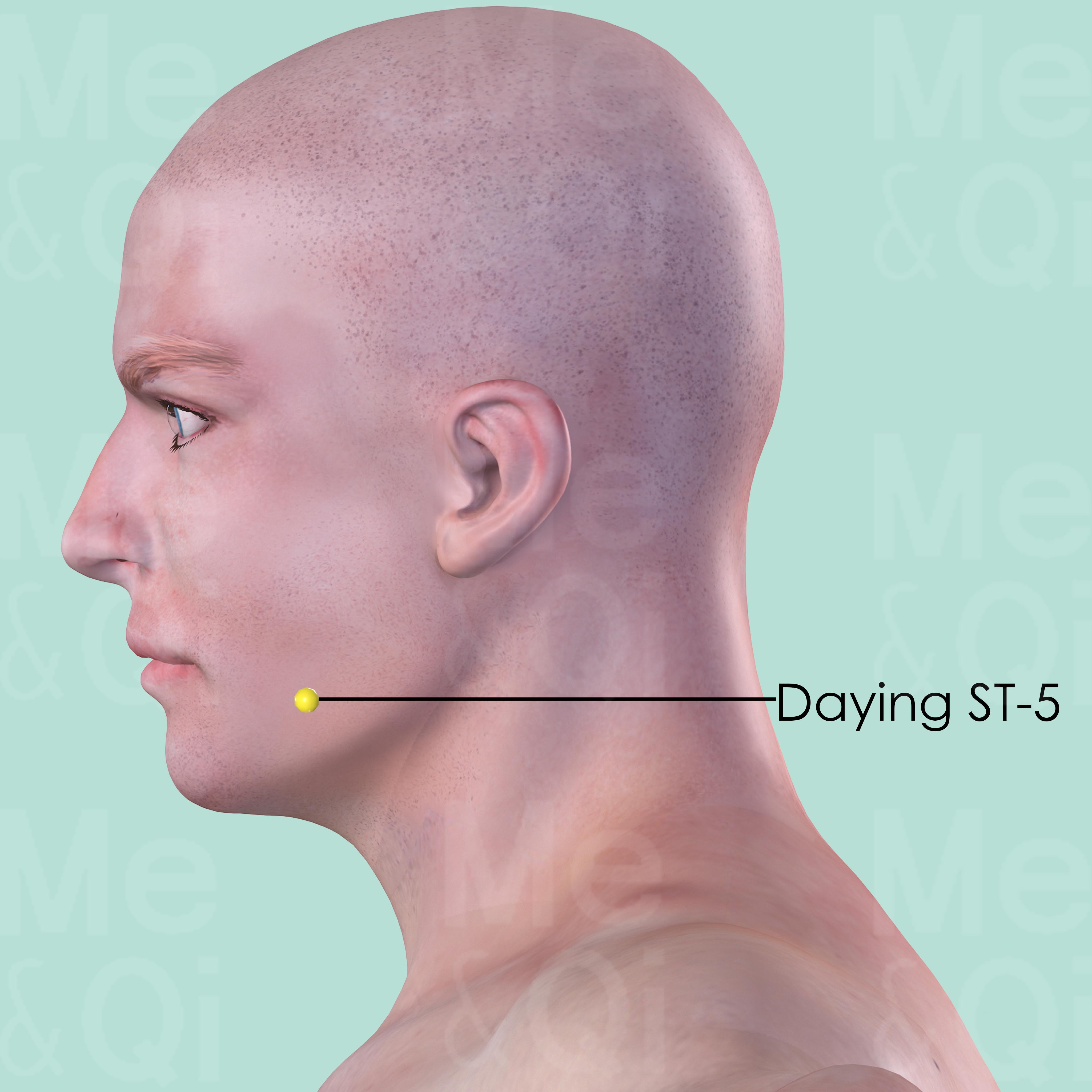
Daying ST-5
On the lateral mandible, on the anterior border of masseter muscle, in the groove-like depression appearing when the cheek is bulged.
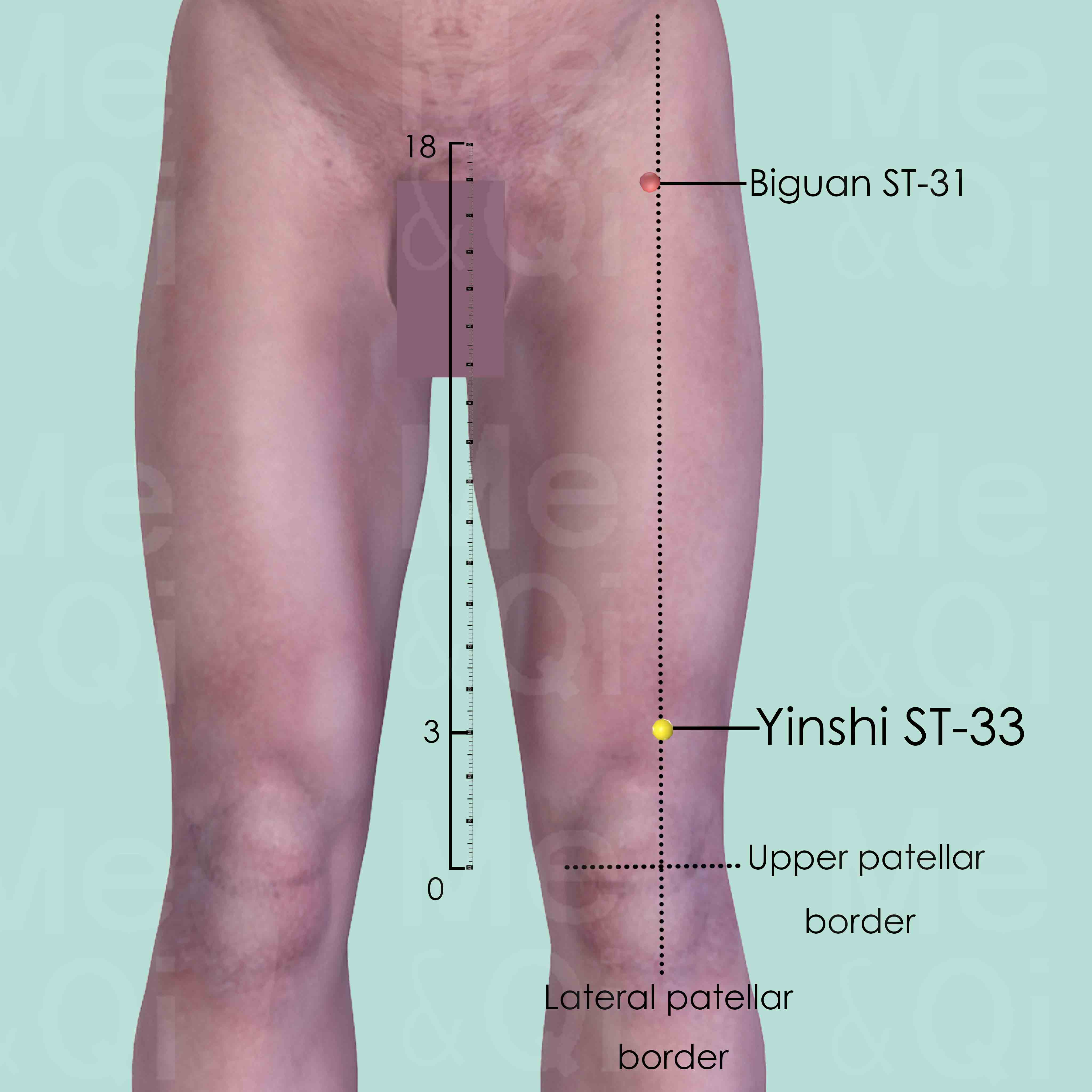
Yinshi ST-33
3 cun above the upper-lateral border of the patella, on a line between the lateral patellar border and the anterior superior iliac spine (ASIS).
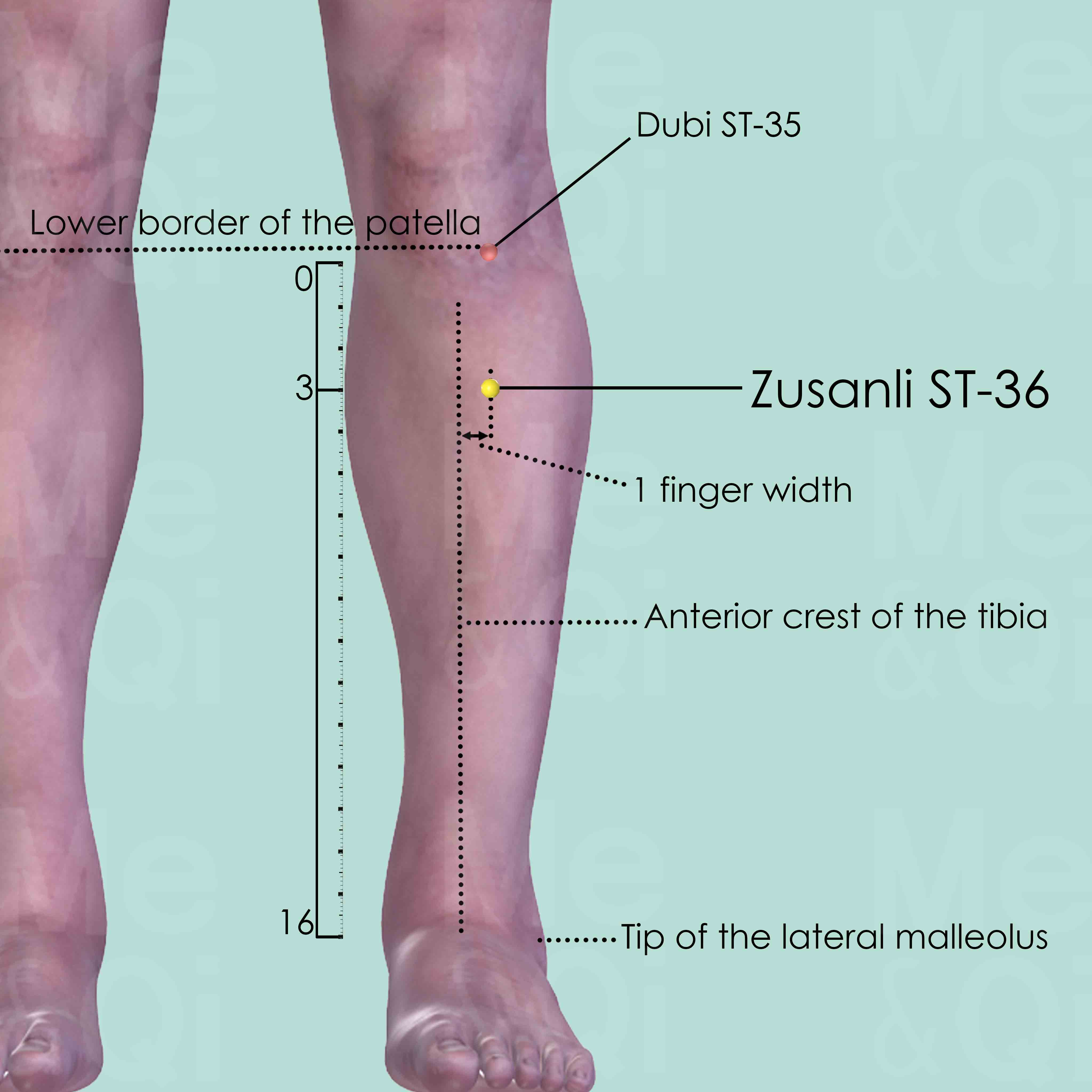
Zusanli ST-36
3 cun below Dubi ST-35, one finger breadth lateral to the anterior crest of the tibia, on the tibialis anterior muscle.
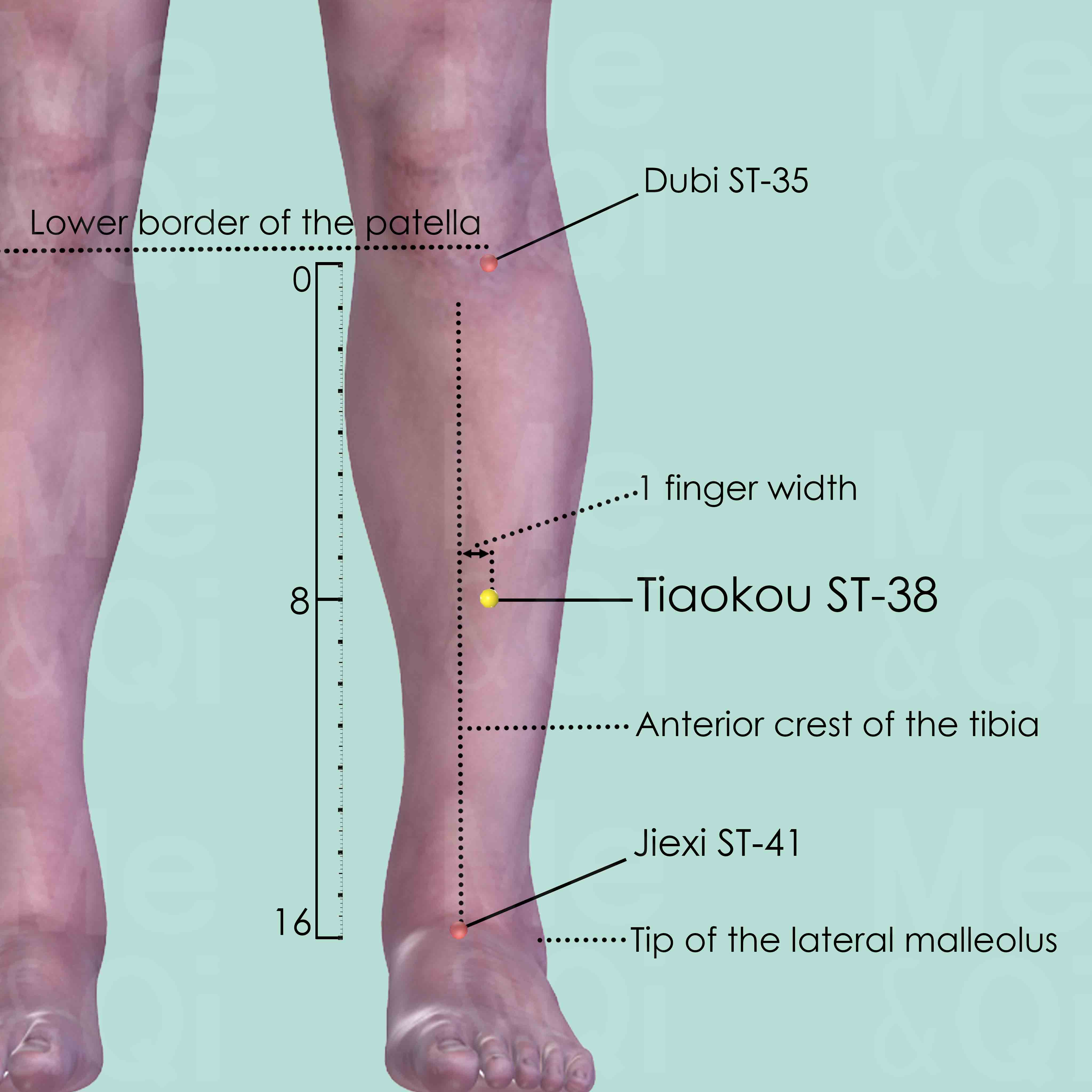
Tiaokou ST-38
8 cun below Dubi ST-35, midway between Dubi ST-35 and Jiexi ST-41, one middle finger-width from the anterior crest of the tibia.
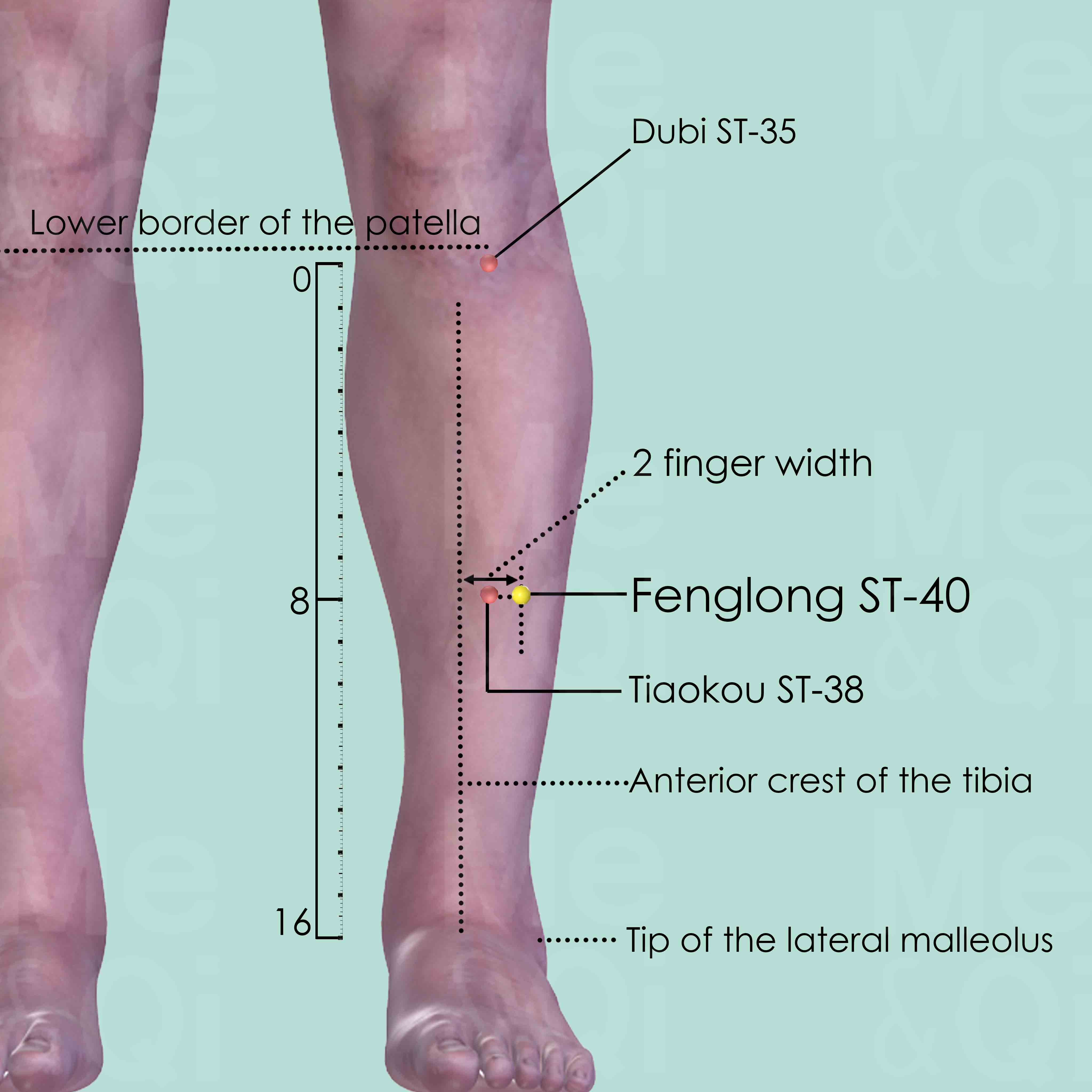
Fenglong ST-40
Midway between Dubi ST-35 and Jiexi ST-41, two middle finger-width from the anterior crest of the tibia, or one middle finger-width from Tiaokou ST-38.
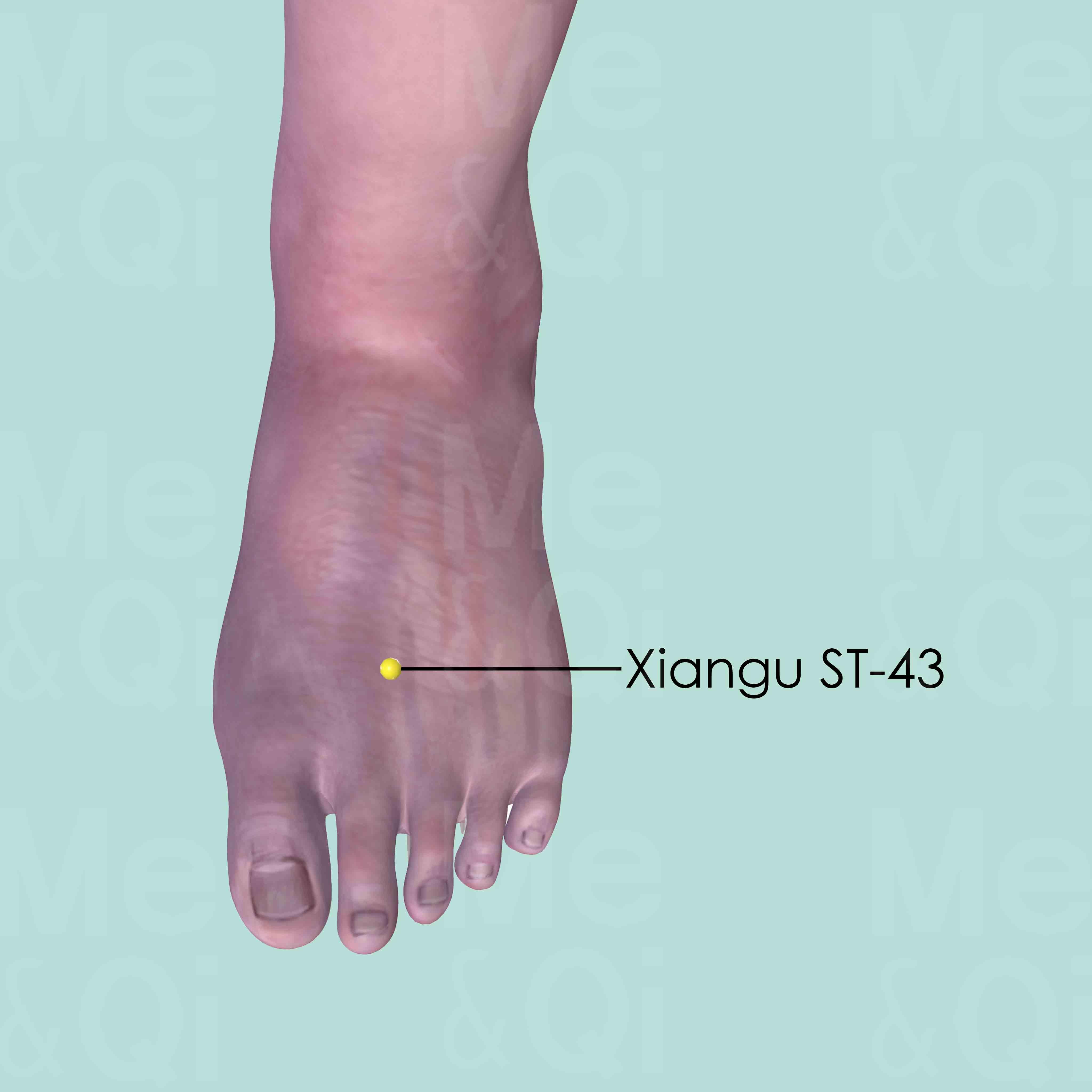
Xiangu ST-43
On the dorsum of the foot, in the depression between the 2nd and 3rd metatarsal bones, at the level of the junction of the shafts and the heads of these metatarsal bones.
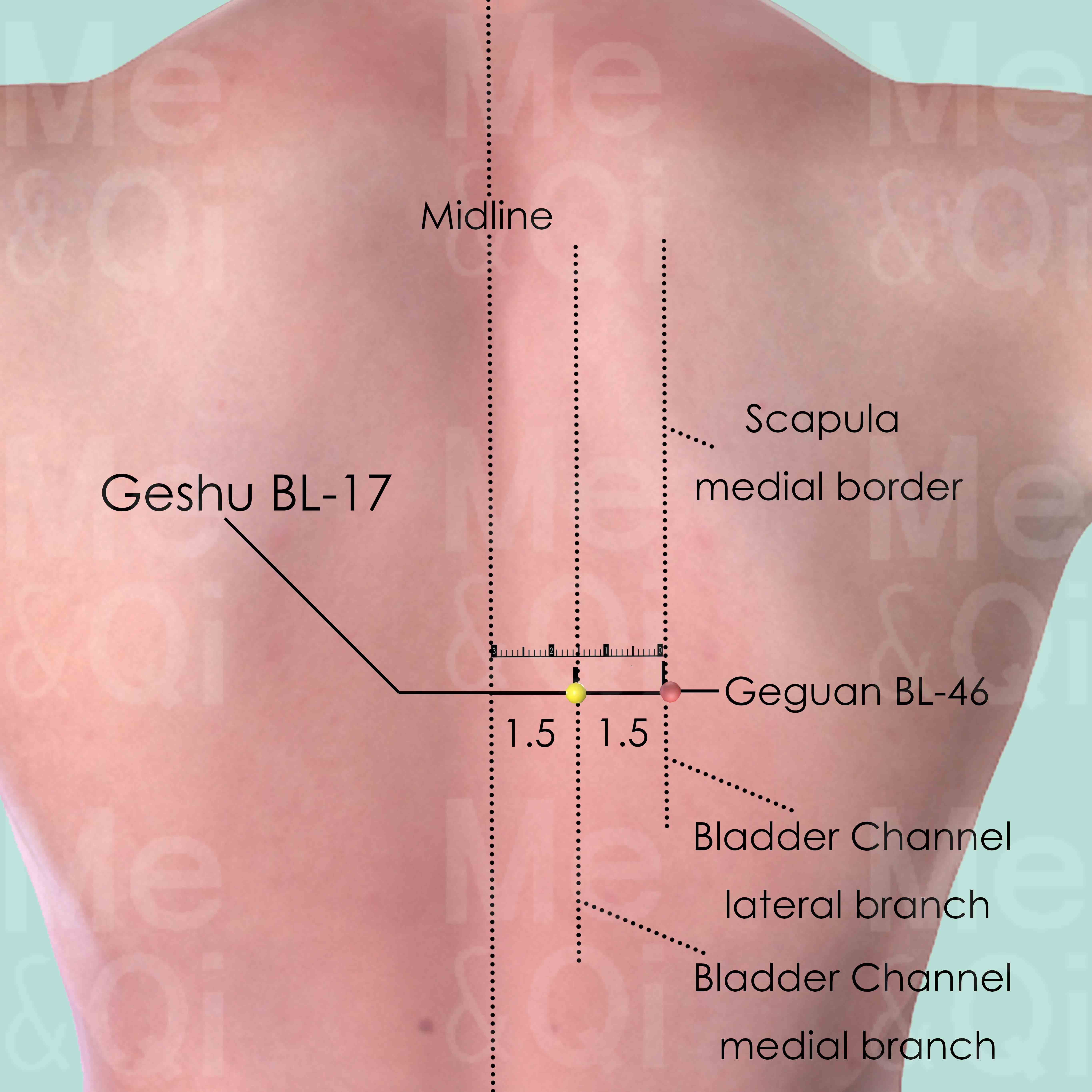
Geshu BL-17
1.5 cun lateral to the lower border of the spinous process of the 7th thoracic vertebra (T7).
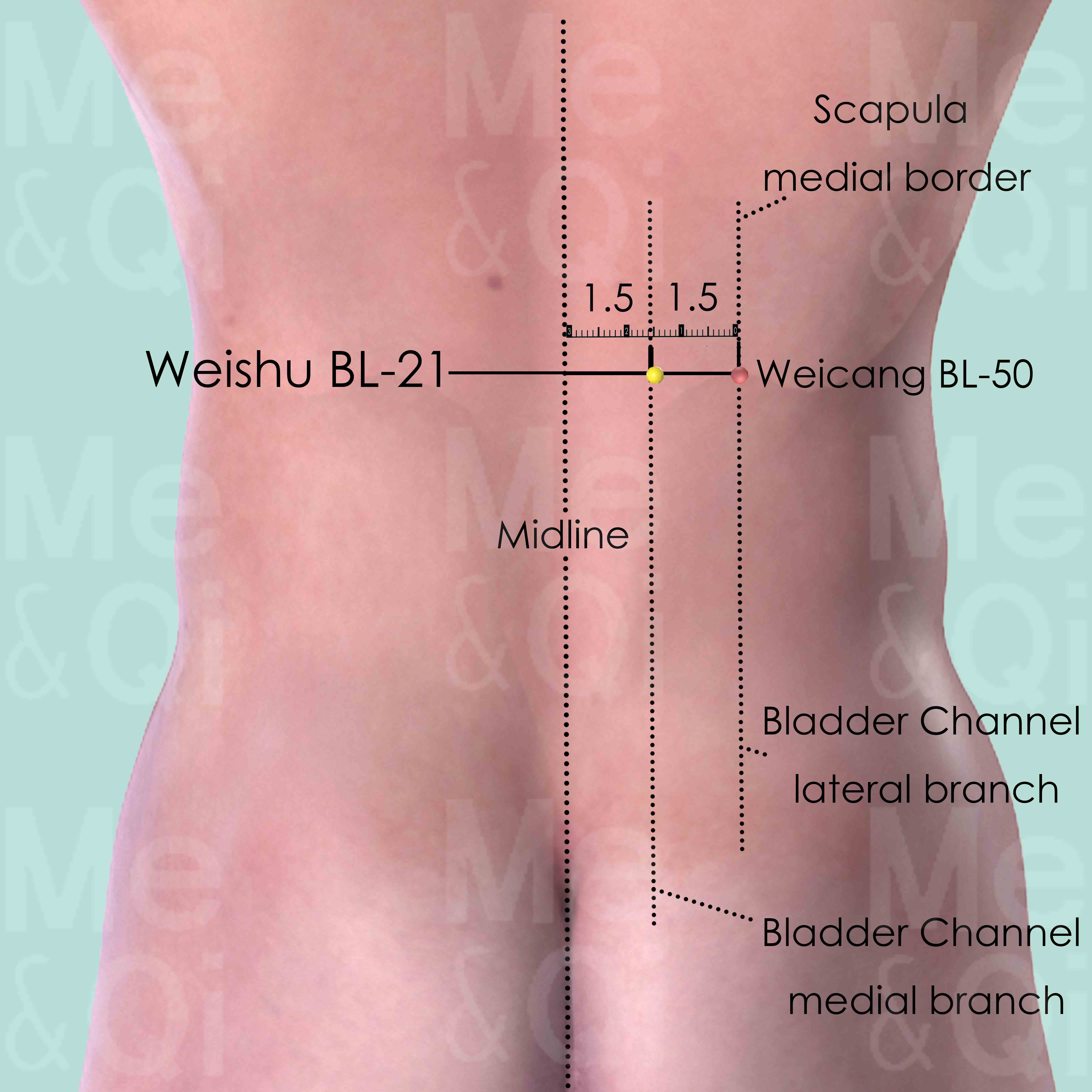
Weishu BL-21
1.5 cun lateral to the lower border of the spinous process of the 12th thoracic vertebra (T12).
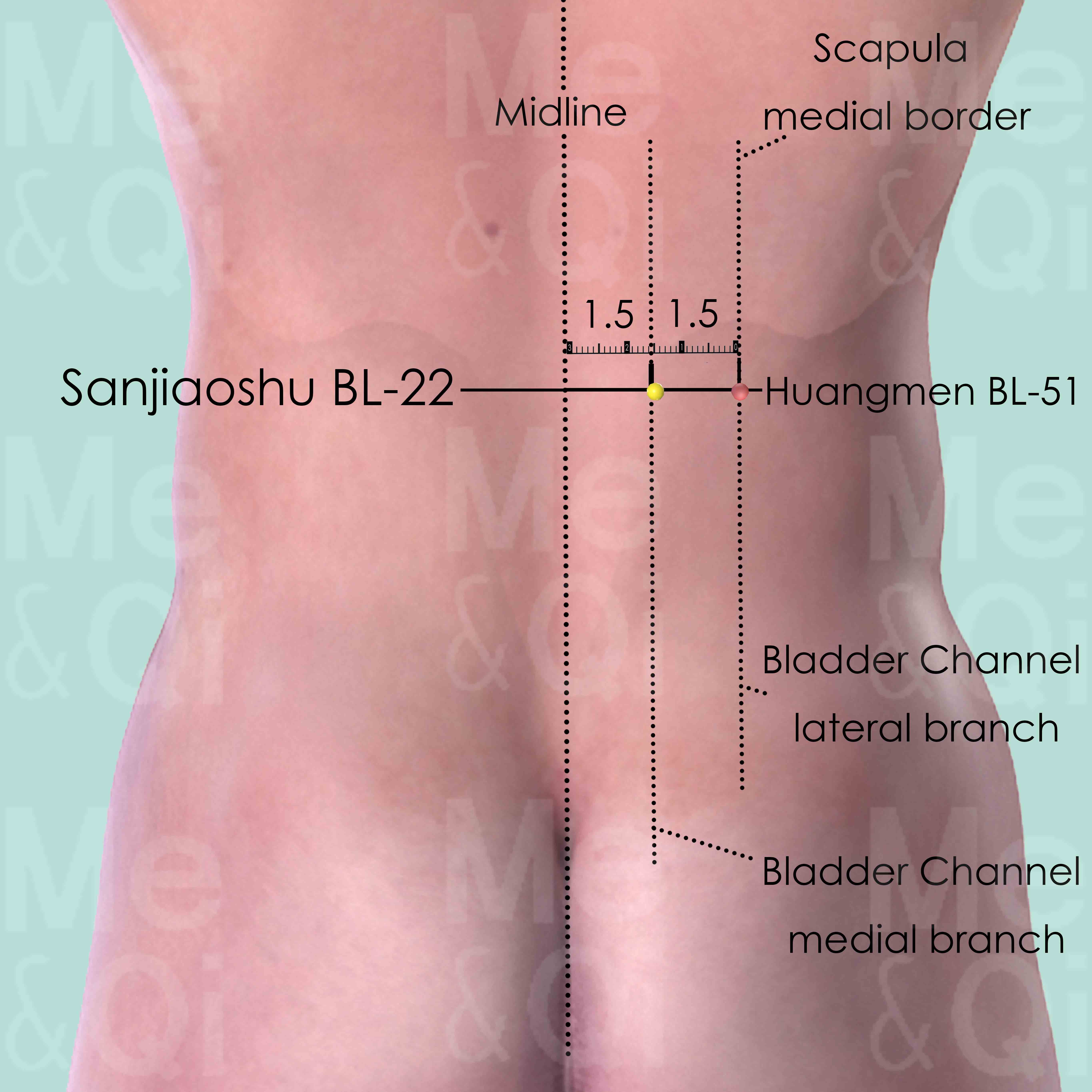
Sanjiaoshu BL-22
1.5 cun lateral to the lower border of the spinous process of the 1st lumbar vertebra.
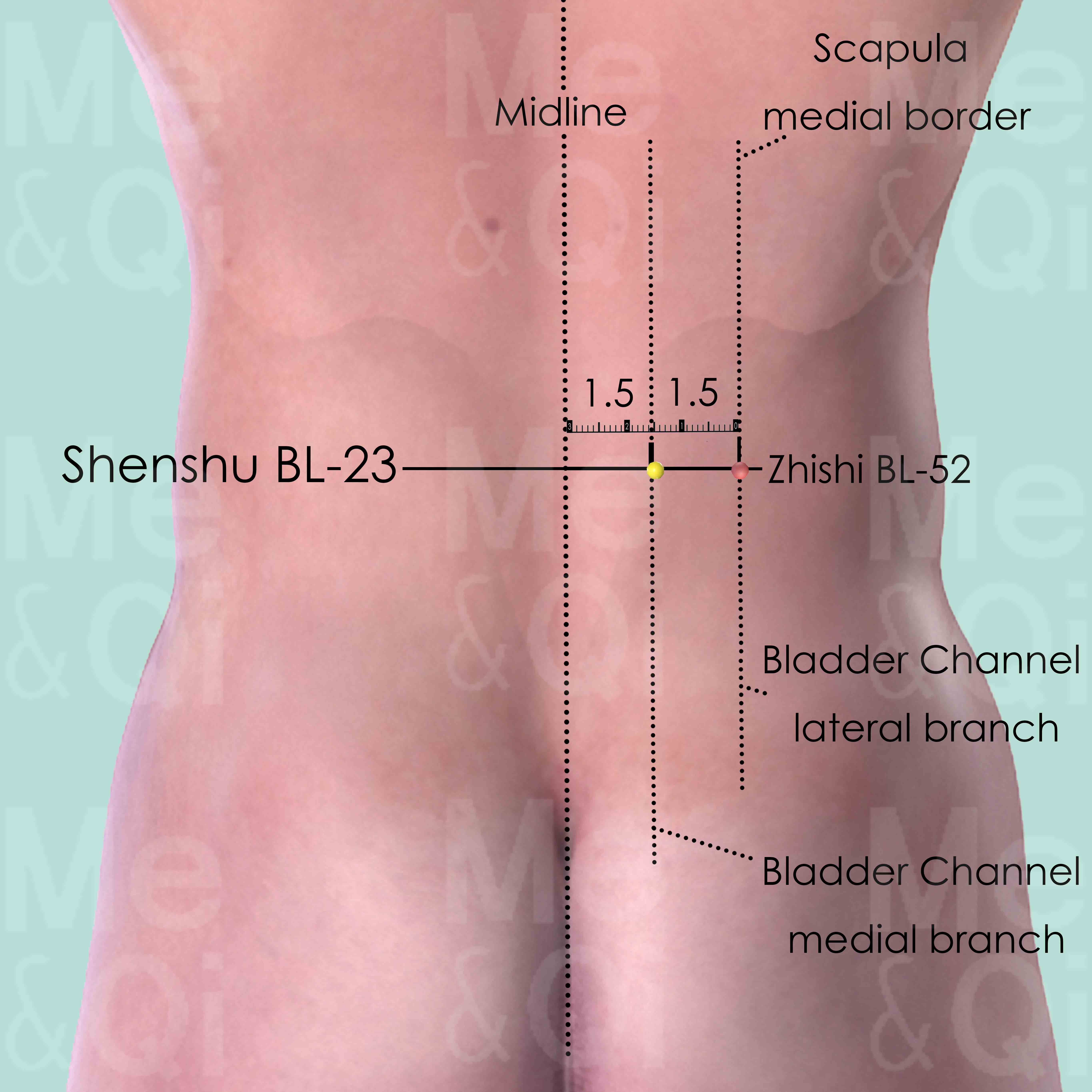
Shenshu BL-23
1.5 cun lateral to the lower border of the spinous process of the 2nd lumber vertebra (L2).
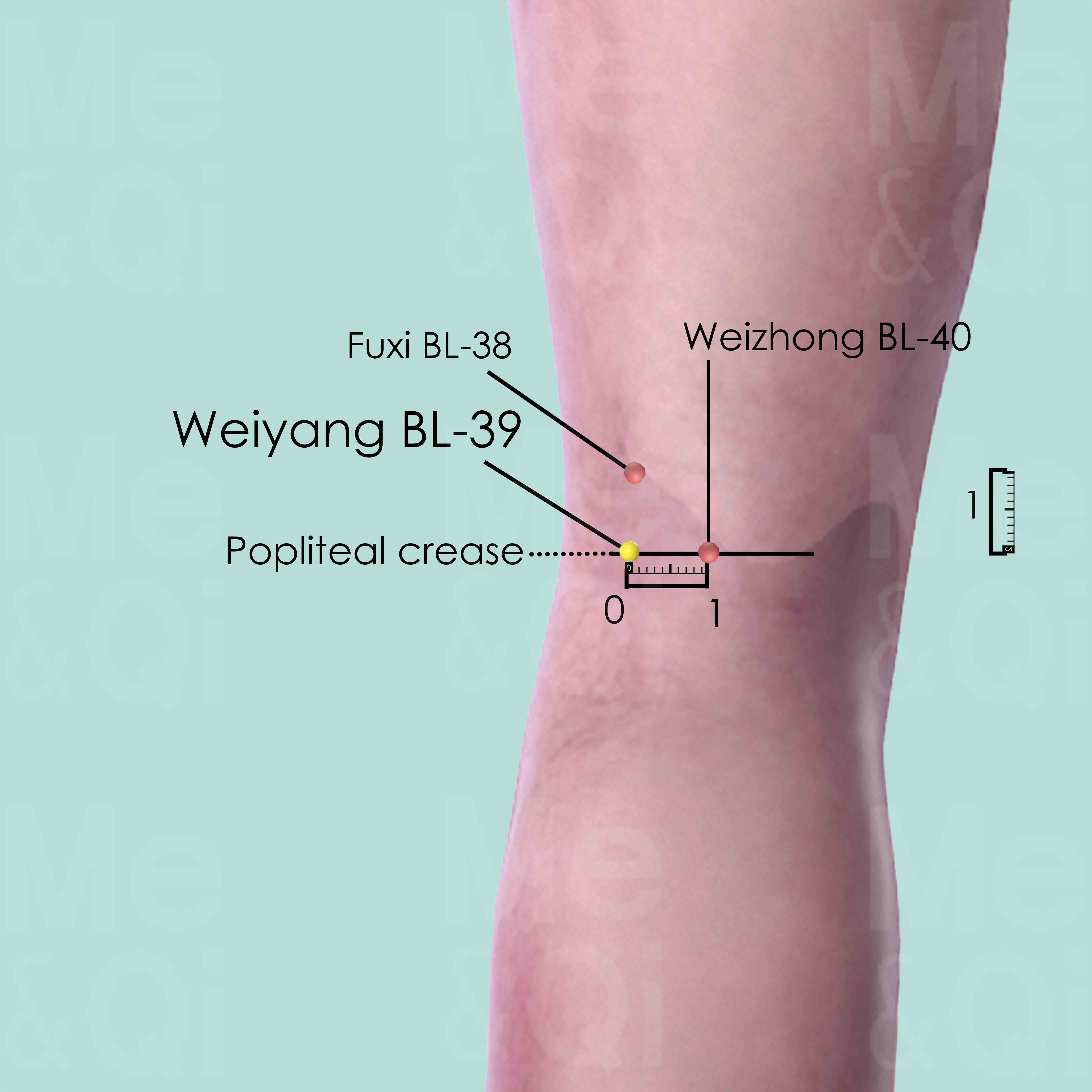
Weiyang BL-39
At the lateral end of the popliteal crease, on the medial border of the tendon of biceps femoris muscle, 1 cun lateral to Weizhong BL-40 which is the midpoint of the popliteal crease. It is also 1 cun below Fuxi BL-38.
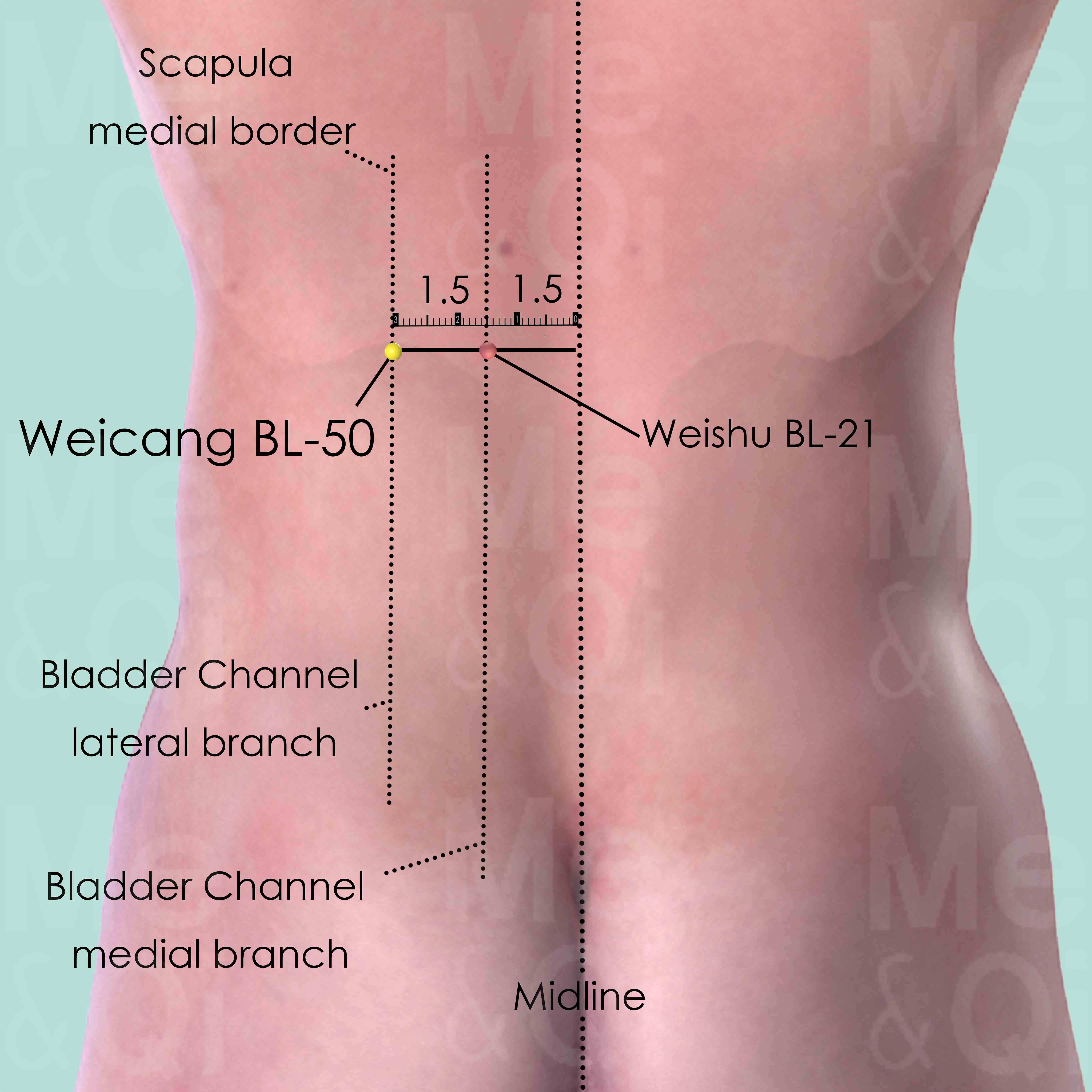
Weicang BL-50
3 cun lateral to the lower border of the spinous process of the 12th thoracic vertebra (T12).
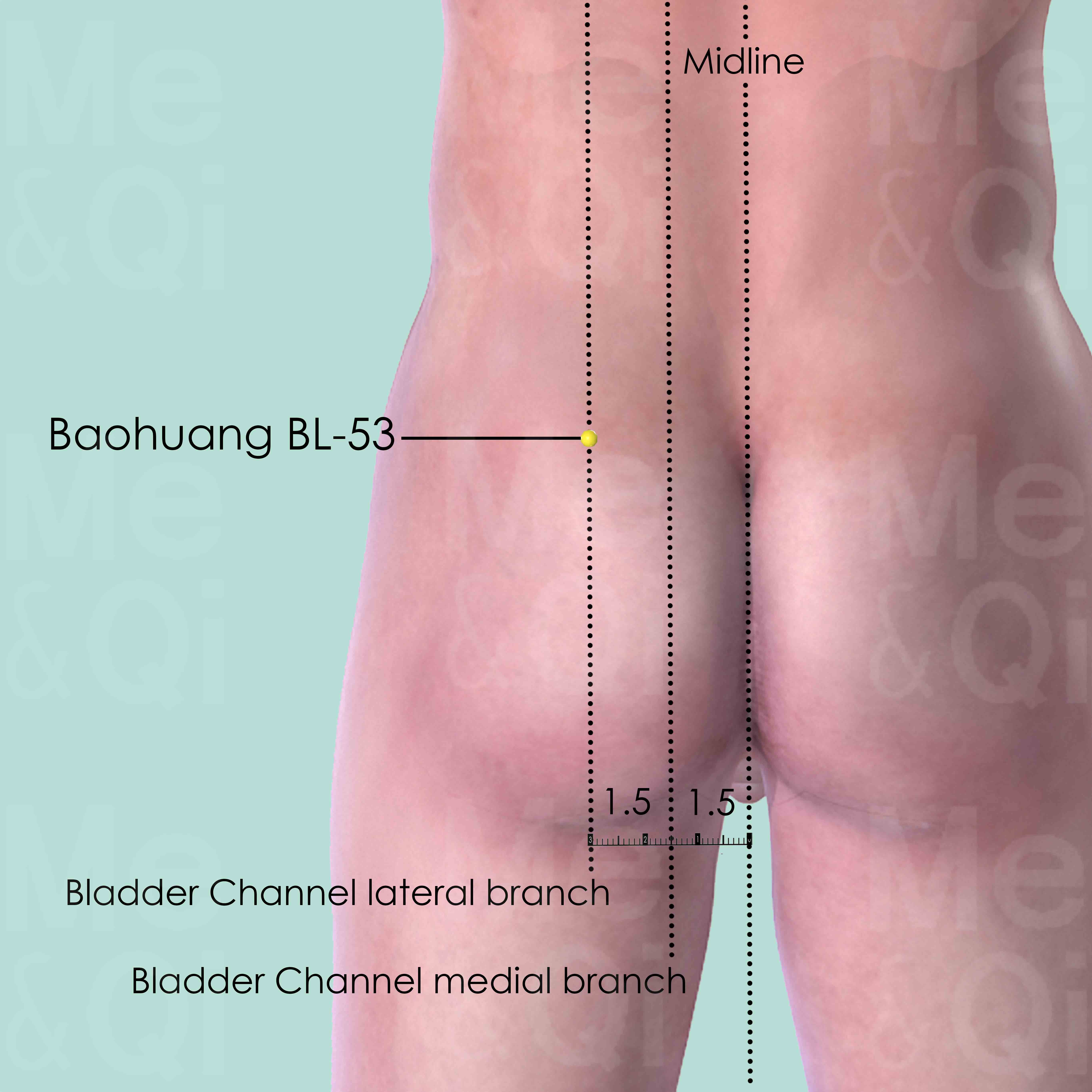
Baohuang BL-53
At the level of the 2nd posterior sacral foramen, 3 cun lateral to the posterior midline.
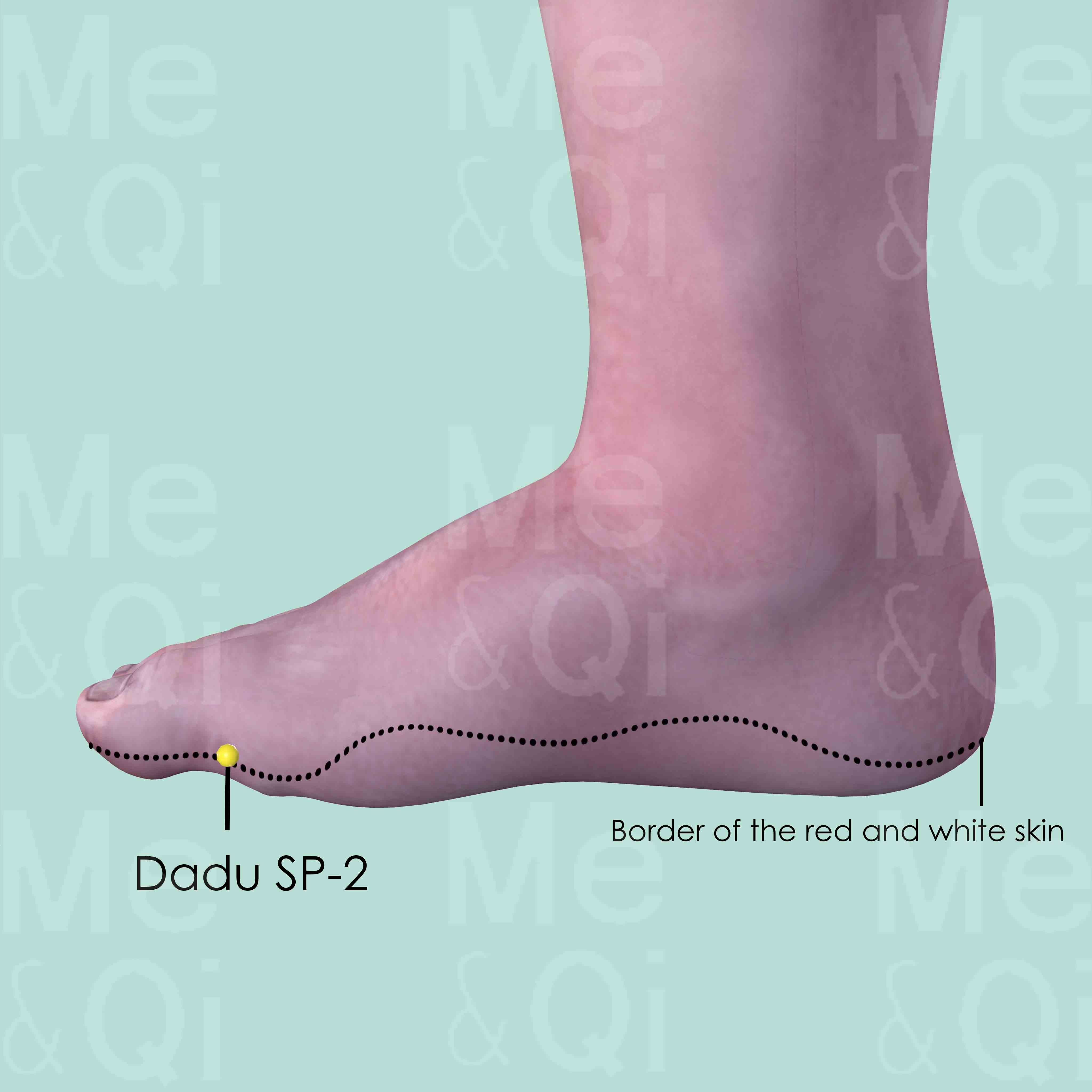
Dadu SP-2
On the medial aspect of the big toe, at the junction of the shaft and the base of the proximal phalanx, distal to the 1st metatarsophalangeal joint.
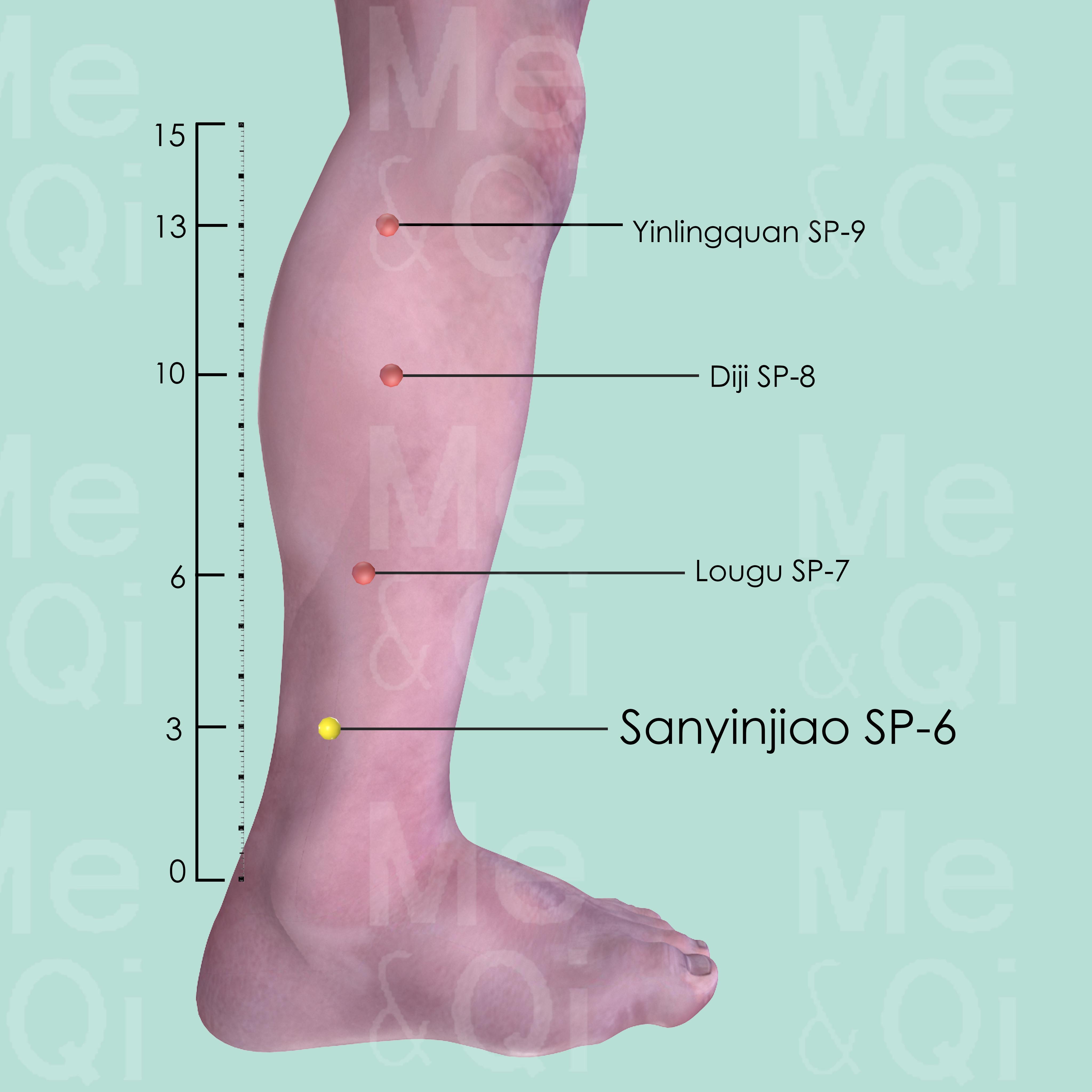
Sanyinjiao SP-6
3 cun directly above the tip of the medial malleolus, on the posterior border of the tibia, on the line drawn from the medial malleolus to Yinlingquan SP-9.
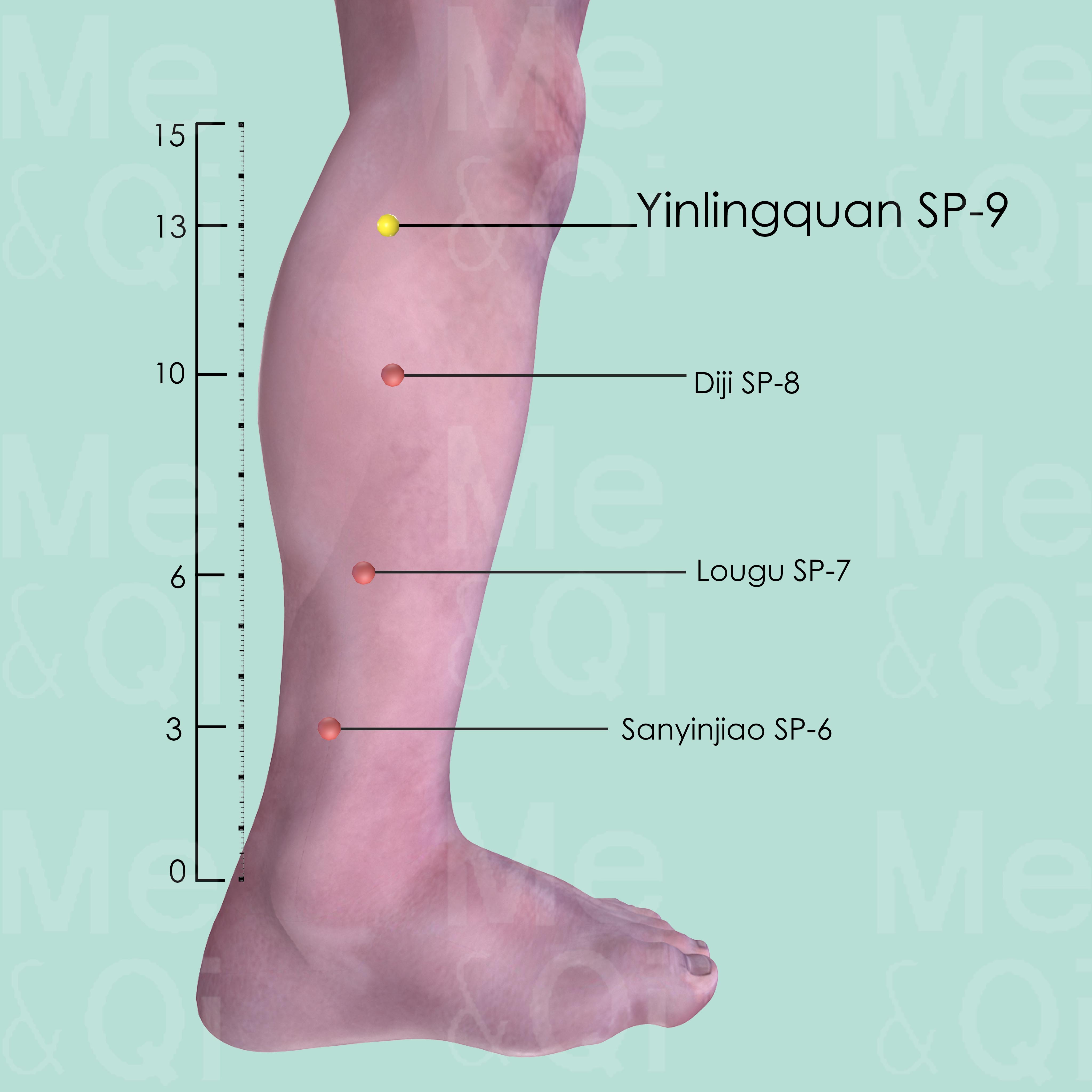
Yinlingquan SP-9
On the lower border of the medial condyle of the tibia, in the depression between the posterior border of the tibia and gastrocnemius muscle.
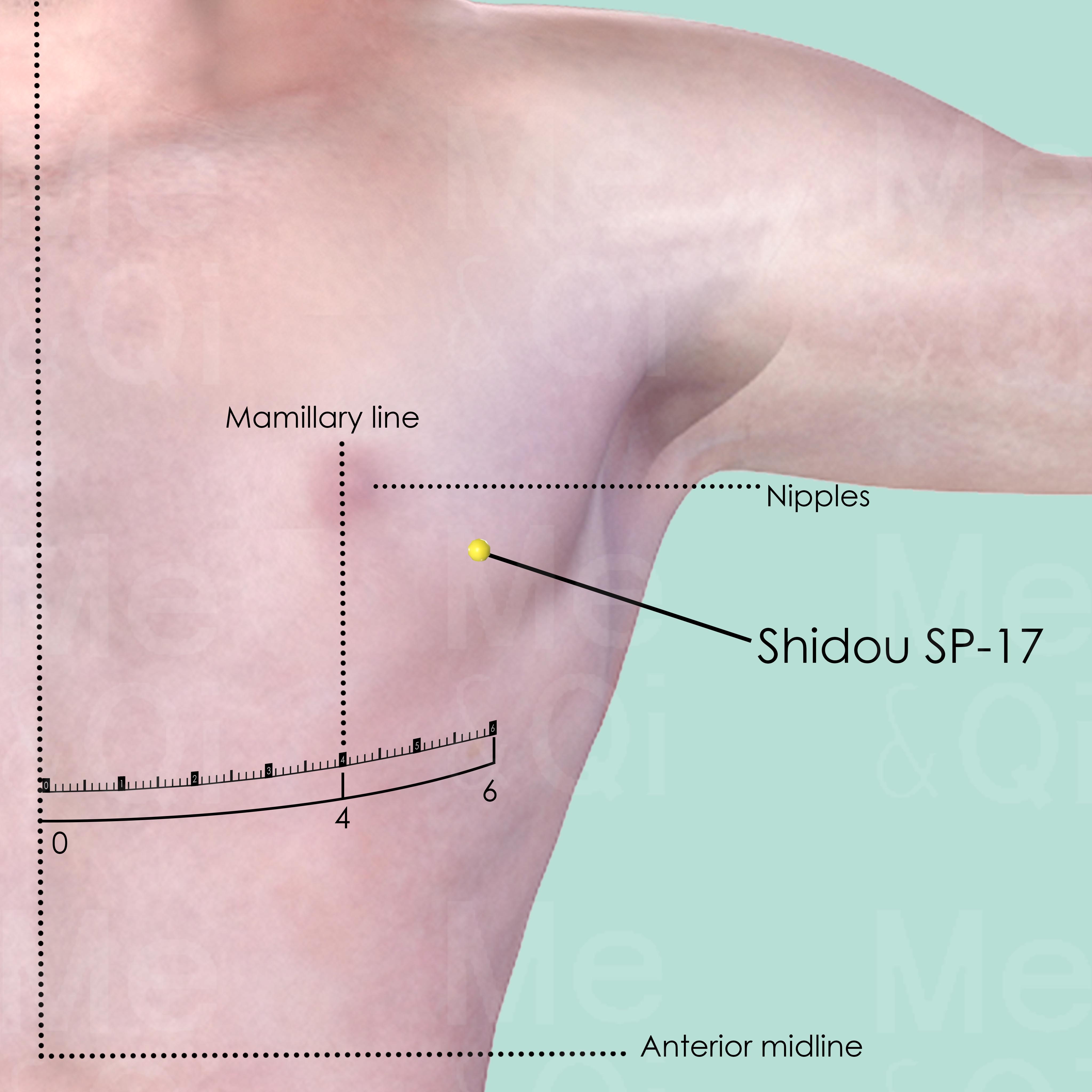
Shidou SP-17
6 cun lateral to the anterior midline, 2 cun lateral to the mamillary line, in the 5th intercostal space.
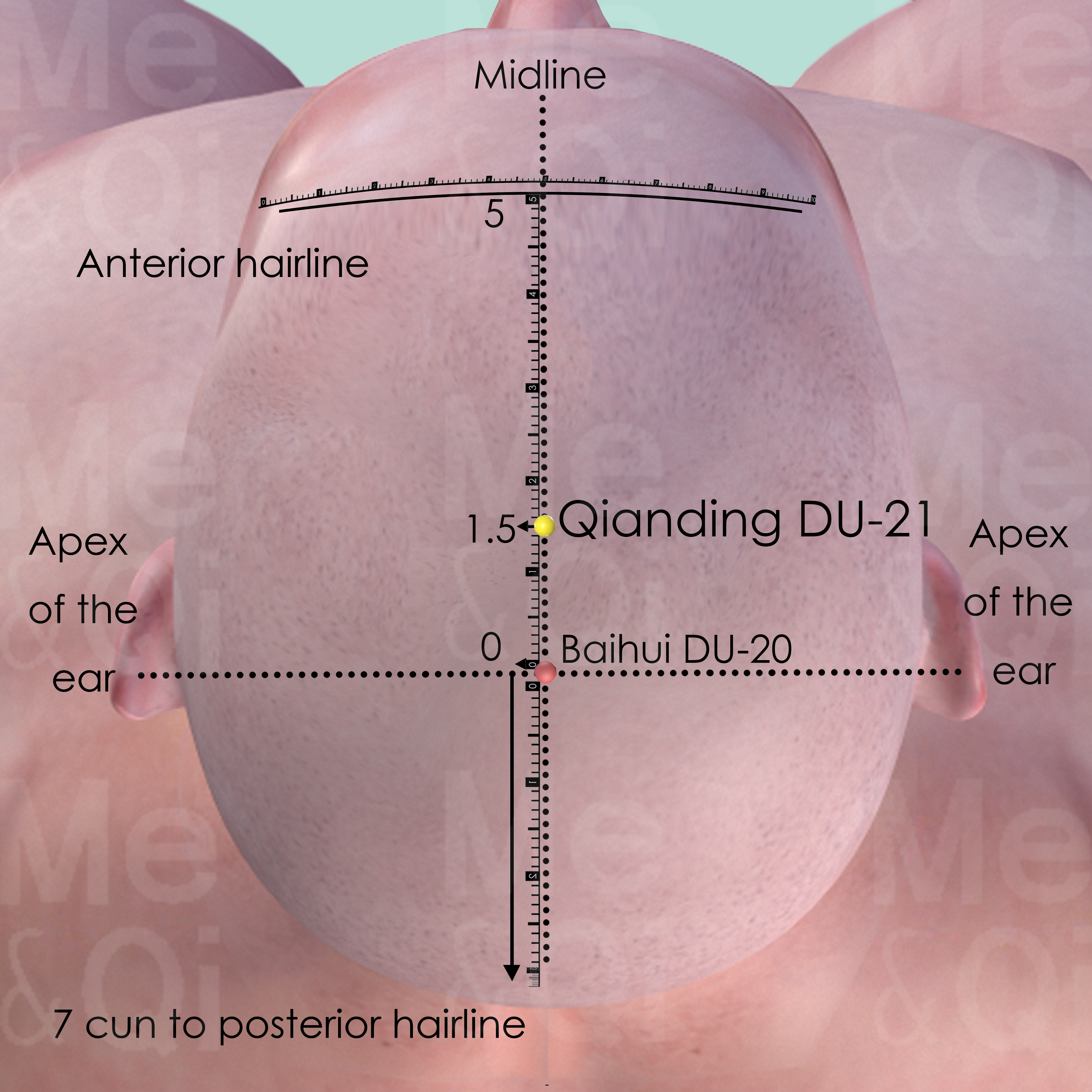
Qianding DU-21
On the midline, 1.5 cun anterior to Baihui DU-20 or 3.5 cun posterior to the anterior hairline.

Xinhui DU-22
On the head midline, 3 cun anterior to Baihui DU-20, 2 cun posterior to the front hairline.
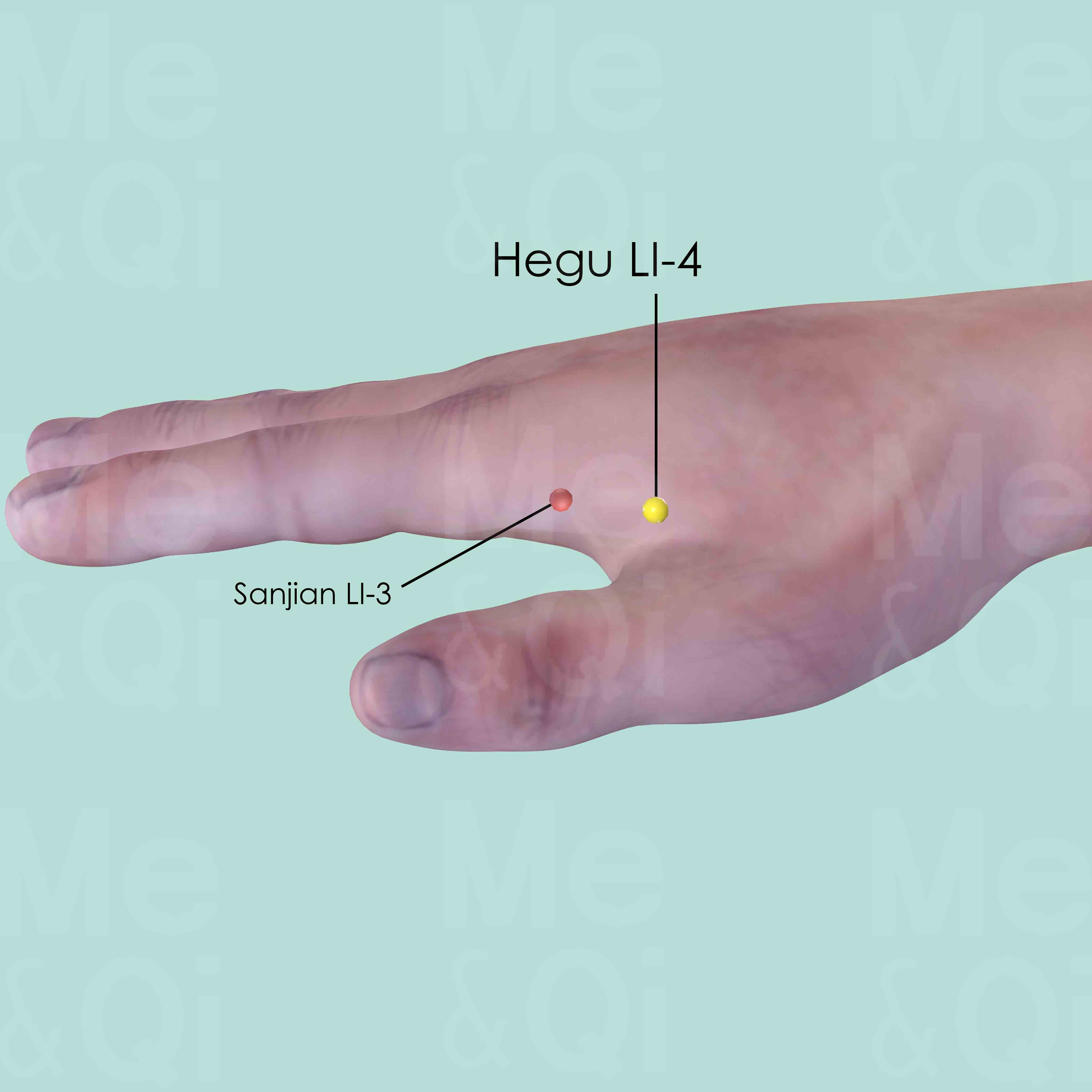
Hegu LI-4
Between the 1st and 2nd metacarpal bones, approximately in the middle of the 2nd metacarpal bone on the radial side.
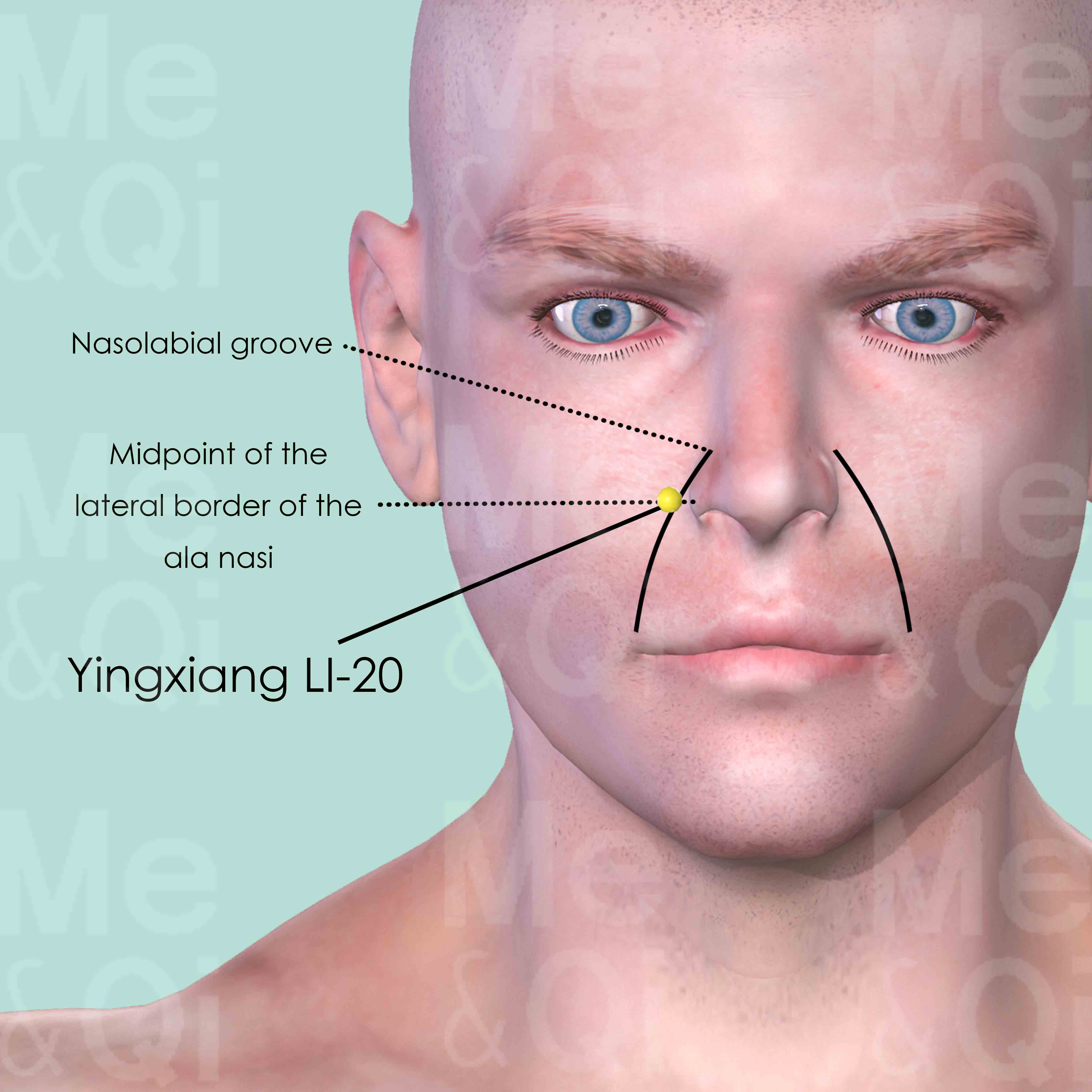
Yingxiang LI-20
In the nasolabrial groove, at the level of the midpoint of the lateral border of ala nasi.
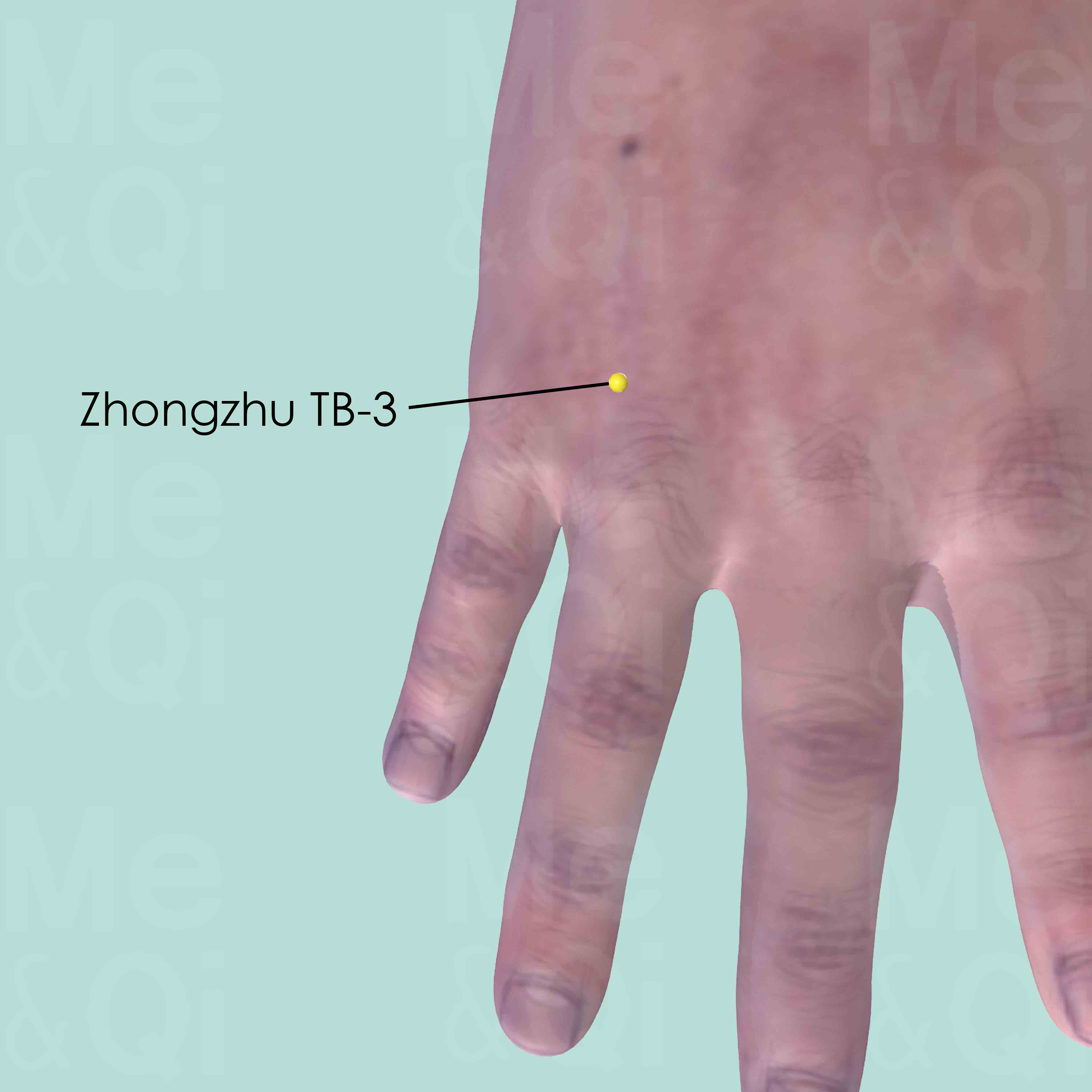
Zhongzhu TB-3
When the hand is placed with the palm facing downward, Zhongzhu TB-3 is on the hand dorsum between the 4th and 5th metacarpal bones, in the depression proximal to the metacarpophalangeal joints, at the junction between the heads and shaft of the two metacarpal bones.
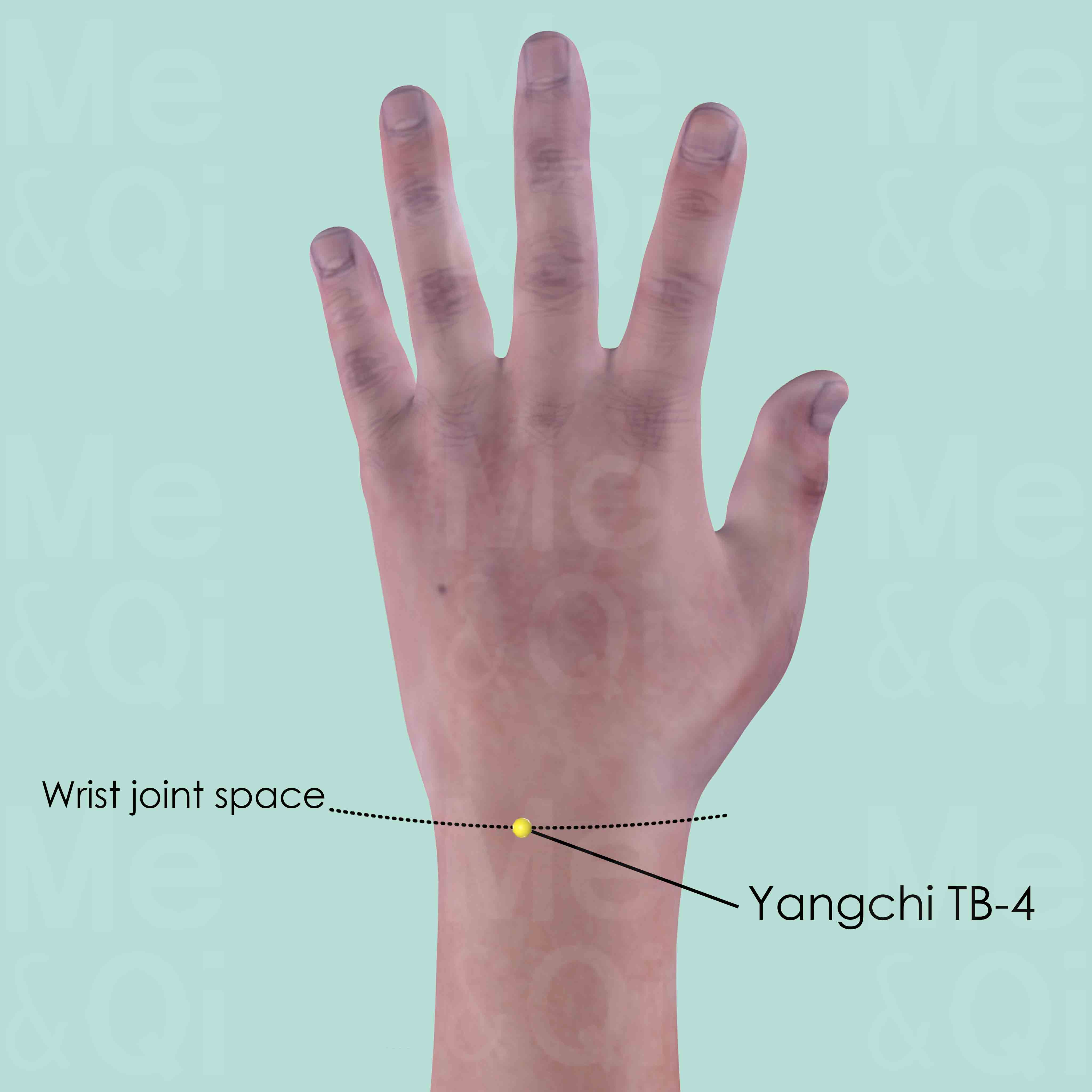
Yangchi TB-4
At the junction of the ulna carpal bones of the wrist dorsum, in the depression lateral to the tendon of extensor digitorum and extensor digiti minimi muscle.
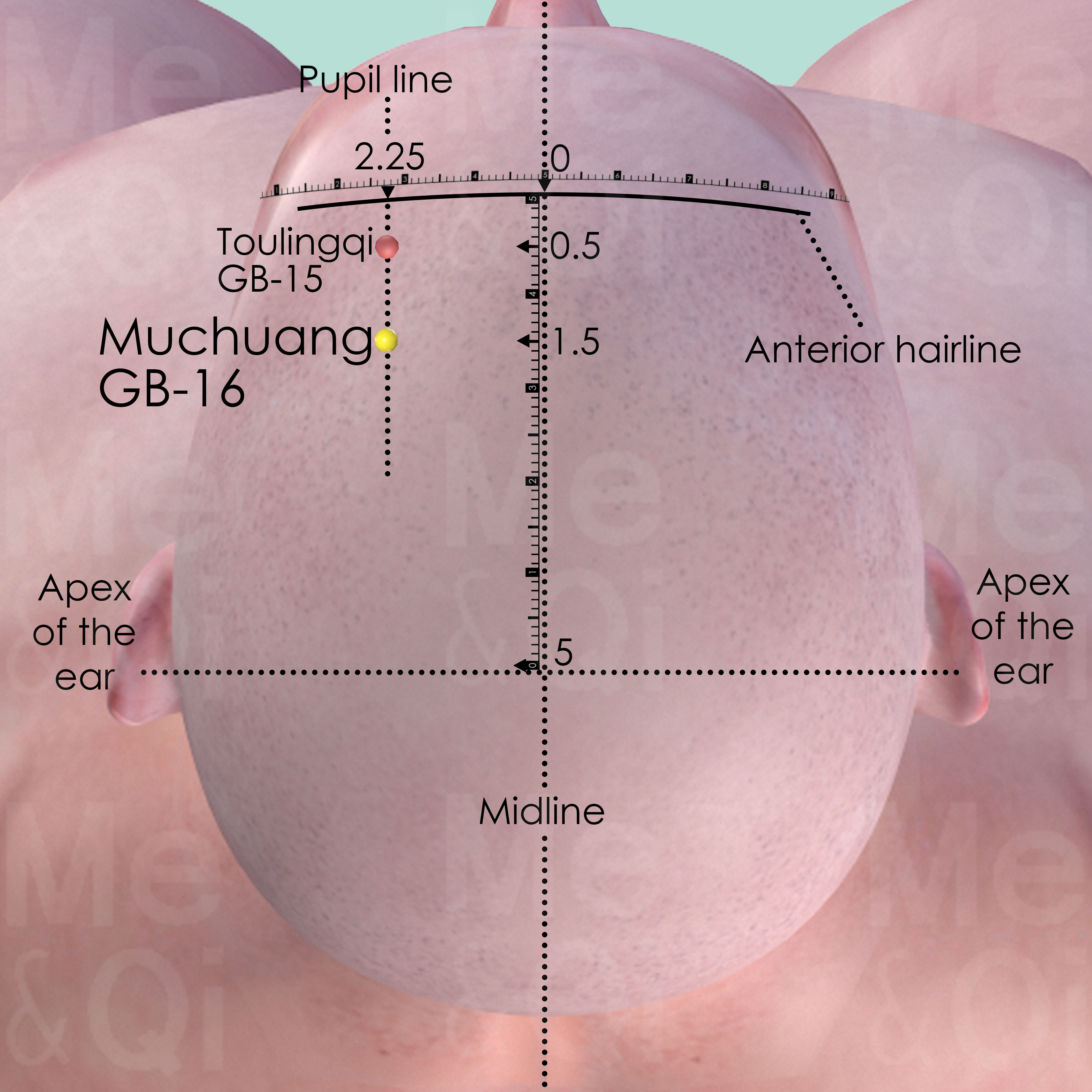
Muchuang GB-16
1 cun posterior to the Toulingqi GB-15 or 1.5 cun posterior to the anterior hairline, on the pupil line which is 2.25 cun lateral to the midline.
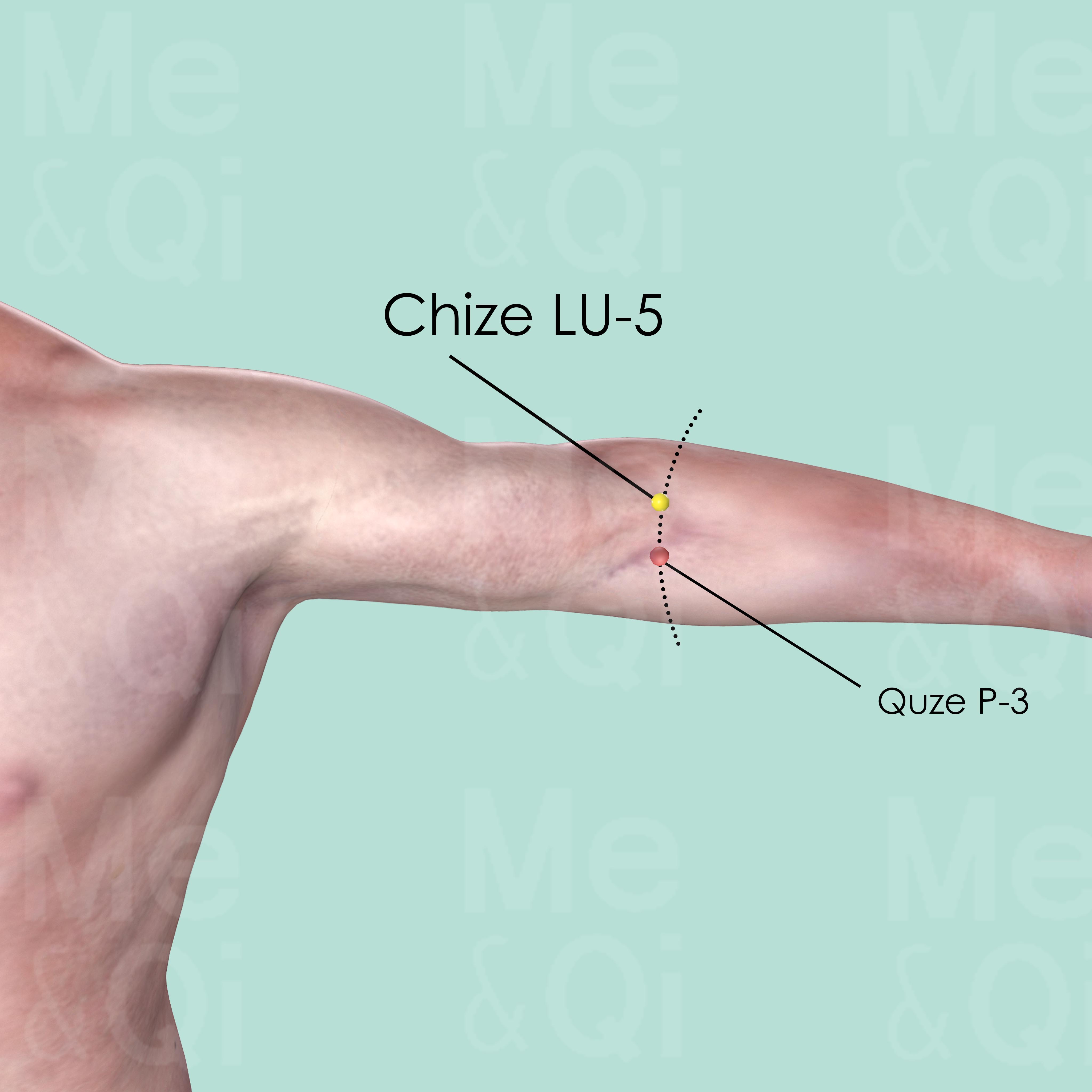
Chize LU-5
On the cubital crease, on the redial aspect of the biceps tendon. It can be easily identified when the elbow is slightly flexed.
